*NURSING > TEST BANK > Test Bank For Health Promotion Throughout the Life Span (Health Promotion Throughout the Lifespan (E (All)
Test Bank For Health Promotion Throughout the Life Span (Health Promotion Throughout the Lifespan (Edelman)) 8th Edition Chapter 1_25/rated A
Document Content and Description Below
Table of Contents Accessibility Front Matter Dedication Contributors Reviewers Previous Contributors Preface Purpose of the Book Approach and Organization Key Features New Features Evolve Resources Fo... r Students For Instructors Acknowledgments Interactive Review – Health Promotion Throughout the Life Span Unit 1 Foundations for Health Promotion Interactive Review – Unit 1 Chapter 1 Health Defined: Objectives for Promotion and Prevention Objectives Key Terms THINK ABOUT IT: Use of Complementary and Alternative Therapies Exploring Concepts of Health Models of Health Clinical Model Role Performance Model Adaptive Model Eudaimonistic Model BOX 1-1 QUALITY AND SAFETY SCENARIO: Fall Prevention in the Home Questions Wellness-Illness Continuum High-Level Wellness FIGURE 1-1 Wellness-illness continuum with high-level wellness added. Moving from the center to the right demonstrates movement toward illness. Moving from the center to the left demonstrates movement toward health. Moving above the line demonstrates movement toward increasing wellness. Moving below the line demonstrates movement toward decreasing wellness. Health Ecology Functioning Health Illness, Disease, and Health Planning for Health Healthy People 2020 Goals BOX 1-2 DIVERSITY AWARENESS: Influence of Personal Cultural Values on Health Care Delivery BOX 1-3 INNOVATIVE PRACTICE: Process for Assessing, Evaluating, and Treating Overweight and Obesity in Adults Case Study Problem Identification Planning Interventions What Was the Actual Cause of Frank’s Problem? Evaluation of the Situation Levels of Prevention BOX 1-4 THE 13 FOCUS AREAS IN HEALTHY PEOPLE 2020 Primary Prevention BOX 1-5 HEALTHY PEOPLE 2020: Selected National Health Promotion and Disease Prevention Objectives for Nutrition and Weight Status Health Promotion The Theoretical Basis of Health Promotion The Social Nature of Health Promotion FIGURE 1-2 The three levels of prevention developed by Leavell and Clark. The Active and Passive Nature of Health Promotion An Application of Theory to the Practice of Health Promotion Specific Protection Examples BOX 1-6 HOT TOPICS: Health Promotion Program Incentives Secondary Prevention Tertiary Prevention The Nurse’s Role Nursing Roles in Health Promotion and Protection Advocate Care Manager Consultant Deliverer of Services Educator Healer Researcher Improving Prospects for Health Population Effects Shifting Problems BOX 1-7 RESEARCH FOR EVIDENCE-BASED PRACTICE: Preventing Functional Decline in Hospitalized Older Adults Moving Toward Solutions CASE STUDY: Health Assessment: Frank Thompson And Family Reflective Questions CARE PLAN: Health Assessment: Frank Thompson and Family Defining Characteristics Related Factors Expected Outcomes Interventions Summary References Pageburst Integrated Resources Chapter 2 Emerging Populations and Health Objectives Key Terms THINK ABOUT IT: A New Brand of Outreach for Chemically Dependent Homeless People Living with HIV/AIDS Health Disparities and Health Equality Emerging Populations in the United States BOX 2-1 HEALTHY PEOPLE 2020: Selected National Health Promotion and Disease Prevention Objectives for Emerging Populations Ethnicity, Ethnic Group, Minority Group, and Race Culture, Values, and Value Orientation BOX 2-2 DIVERSITY AWARENESS: Female Genital Mutilation: Taboo or Tradition Cultural Competency BOX 2-3 HOT TOPICS: Culturally Competent Care Among Nurses Folk Healing and Professional Care Systems Arab Americans Health Care Issues of Arab Americans Selected Health-Related Cultural Aspects FIGURE 2-1 (A, B) The Arab culture values prescribed rituals for praying and cultural dress. Asian Americans/Pacific Islanders Health Care Issues of Asian Americans/Pacific Islanders Selected Health-Related Cultural Aspects Latino/Hispanic Americans BOX 2-4 RESEARCH FOR EVIDENCE-BASED PRACTICE: Use of Complementary and Alternative Medicine (CAM) in the United States Health Issues of Latino/Hispanic Americans Selected Health-Related Cultural Aspects Blacks/African Americans Health Issues of Blacks/African Americans Selected Health-Related Cultural Aspects American Indians/Alaska Natives Health Care Issues of Native Americans Selected Health-Related Cultural Aspects The Emerging Rural and Urban Populations: Homeless Persons Homelessness: A Continuing Saga Why Families and Persons Become Homeless Health Issues of Homeless Persons and Families FIGURE 2-2 A homeless man works at a day labor job to earn some money. Strategies to Address Homelessness The Nation’s Response to the Health Challenge Healthy People 2020 Office of Minority Health Nursing’s Response to Emerging Populations and Health BOX 2-5 INNOVATIVE PRACTICE: Spiritual Practices and Health BOX 2-6 QUALITY AND SAFETY SCENARIO: Immigrants and Health Care Providers BOX 2-7 STUDENT HEALTH PROMOTION PROJECT CASE STUDY: An Older Immigrant Couple: Mr. and Mrs. Arahan Reflective Questions CARE PLAN: An Older Immigrant Couple: Mr. and Mrs. Arahan Defining Characteristics Related Factors Expected Outcomes Interventions Summary References Pageburst Integrated Resources Interactive Student Exercises Chapter 3 Health Policy and the Delivery System Objectives Key Terms THINK ABOUT IT: The Federal Health Care Reform Law The Health of The Nation Healthy People 2020 BOX 3-1 HEALTHY PEOPLE 2020: Overarching Goals for Healthy People 2020 Health Indicators of a Nation BOX 3-2 VULNERABLE POPULATIONS TABLE 3-1 INTERNATIONAL COMPARISONS OF CORE HEALTH INDICATORS FOR 2011 TABLE 3-2 INTERNATIONAL COMPARISON OF LIFE EXPECTANCY RATES (IN YEARS) OVER TIME FOR 1990, 2000, AND ESTIMATES OF 2011 FIGURE 3-1 Infant mortality rates for mothers ages 20 years and older by race/ethnicity and education, 2003 to 2005. TABLE 3-3 INFANT MORTALITY RATE IN THE UNITED STATES BY RACE/ETHNICITY, 2007 TABLE 3-4 INFANT MORTALITY RATES IN 2007, BY TRIMESTER IN WHICH PREGNANCY CARE WAS STARTED, SMOKING STATUS DURING PREGNANCY, AND EDUCATION OF MOTHER Historical Role of Women in Health Promotion A Safer System Global Health Historical Perspectives History of Health Care Early Influences Industrial Influences Socioeconomic Influences Public Health Influences Scientific Influences Special Population Influences Political and Economic Influences BOX 3-3 DIVERSITY AWARENESS: Health and Human Services Action Plan to Reduce Racial and Ethnic Health Disparities Community-Driven Approach to Reduce Health Disparities in the United States Split Between Preventive and Curative Measures Organization of The Delivery System Private Sector Independent Practice BOX 3-4 TYPES OF AMBULATORY CARE SETTINGS Move to Managed Care Health Maintenance Organizations BOX 3-5 A GLOSSARY OF MANAGED CARE TERMS Medicare Advantage Plans Independent Practice Associations Accountable Care Organizations BOX 3-6 HOT TOPICS: Medicare Advantage Plans Concierge Medical Practices Hospitalist Movement Point-of-Service Plans High-Deductible Health Insurance Plans Preferred Provider Organizations Public Sector FIGURE 3-2 Total health expenditure per capita, United States and selected countries, 2008. Source of Power Influence of Political Philosophy BOX 3-7 THE DEPARTMENT OF HEALTH AND HUMAN SERVICES (HHS) The Federal Public Health Service Agencies BOX 3-8 RESEARCH FOR EVIDENCE-BASED PRACTICE: Connecting Eligible Immigrant Families to Health Coverage and Care: Key Lessons from Outreach and Enrollment Workers, October 2011 Methodology Recommendations and Conclusions Current Health Policy BOX 3-9 SECTIONS OF THE AFFORDABLE CARE ACT Future Health Policy Nursing’s Role in Leading Change—2010 Recommendations of the IOM Report on the Future of Nursing Official Agencies Local Level BOX 3-10 INNOVATIVE PRACTICE: IOM’s October 5, 2010, Report on the Future of Nursing Recommendations State Level Federal Level Chief Nursing Officer Federal Emergency Management Agency (FEMA) Military Health Systems at the Federal Level Wounded Warrior Care Americans with Disabilities Federal Health Information Privacy Law International Level Voluntary Agencies The American Red Cross Financing Health Care Costs FIGURE 3-3 Growth in total health expenditure per capita, United States and selected countries, 1970 to 2008. Notes: Data for Canada, Norway, and Switzerland, are OECD estimates. Numbers are PPP-adjusted. Break in series: CAN (1995); SWE (1993, 2001); SWI (1995); UK (1997). Numbers are PPP-adjusted. Estimates for Canada and Switzerland in 2008. FIGURE 3-4 Total expenditure on health care as a share of GDP. Notes: Data from Australia and Japan are 2007 data. 2008 data from Belgium, Canada, Netherlands, Norway, and Switzerland are OECD estimates. 2000 numbers for Belgium are OECD estimates. Numbers are PPP-adjusted. Break in Series: AUS(1998); AUSTRIA(1990); BEL(2003, 2005); CAN(1995); FRA(1995); GER(1992); JAP(1995); NET(1998, 2003); NOR(1999); SPA(1999, 2003); SWE(1993, 2001); SWI(1995); UK (1997). Starting in 1993, Belgium used a different methodology. FIGURE 3-5 Total expenditure on health care as a share of the GDP. Note: Medicaid also includes other public programs: CHIP, other state programs, military-related coverage. Numbers may not add to 100% because of rounding. FIGURE 3-6 Nation’s health dollars, calendar year 2010: where it come from. Note: Sum of pieces may not equal 100% because of rounding. 1Includes worksite health care, other private revenues, Indian Health Service, workers’ compensation, general assistance, maternal and child health, vocational rehabilitation, Substance Abuse and Mental Health Services. 2Includes copayments, deductibles, and any amounts not covered by health insurance. Sources Employer Health Benefits FIGURE 3-7 Nation’s health dollars ($2.6 trillion), calendar year 2010: where it went. Note: Sum of pieces may not equal 100% because of rounding. 1Includes research (2%) and structures and equipment (4%). 2Includes durable (1%) and nondurable (2%) goods. 3Includes expenditures for residential care facilities, ambulance providers, medical care delivered in nontraditional settings (such as community centers, senior citizens centers, schools, and military field stations), and expenditures for Home and Community Waiver programs under Medicaid. FIGURE 3-8 Average annual health insurance premiums and worker contributions for family coverage, 2009 to 2011. FIGURE 3-9 Medicaid enrollees and expenditures, fiscal year 2008. FIGURE 3-10 Medicaid expenditures by service, 2009. Note: Total may not add to 100% because of rounding. Excludes administrative spending, adjustments, and payments to the territories. Mechanisms Payment Cost Containment Care Management BOX 3-11 CARE MANAGEMENT SERVICES Managed Care Issues Health Insurance Private Health Insurance Public Health Insurance and Assistance Medicare FIGURE 3-11 Medicare spending as a percent of total federal spending, fiscal year 2010. Notes: FY is fiscal year. 1Amount for Medicare includes offsetting premium receipts. 2Other category includes disaster costs and negative outlays for Troubled Asset Relief Program. FIGURE 3-12 Medicare enrollment, 1966 to 2010. Notes: Numbers may not sum to total because of rounding. People with disabilities under age 65 were not eligible for Medicare before 1972. Medicaid FIGURE 3-13 Medicaid has many vital roles in our health care system. FIGURE 3-14 Medicaid’s role for selected populations. Pharmaceutical Costs The Uninsured: Who Are They? Illegal Immigrants Health Care Systems of Other Countries Canadian Health Care System BOX 3-12 FIVE PRINCIPLES OF THE CANADA HEALTH ACT CASE STUDY: Health teaching: Using The Internet to Increase Health Literacy Reflective Questions Summary References Pageburst Integrated Resources Chapter 4 The Therapeutic Relationship Objectives Key Terms THINK ABOUT IT: How Does a Nurse Respond When an Individual’s Values Conflict with the Nurse’s Value of Promoting Healthy Behaviors? Values Clarification Definition BOX 4-1 HEALTHY PEOPLE 2020 Leading Health Indicators Priorities for Action BOX 4-2 THE VALUING PROCESS Choosing Prizing Acting BOX 4-3 TECHNIQUES FOR ASSISTING INDIVIDUALS TO CLARIFY VALUES Identify the Individual’s Values Use Reflection to Restate the Value and Make it Explicit Identify Value Conflicts or Conflicts Between Values and Actions Values and Therapeutic Use of Self FIGURE 4-1 Johari window. BOX 4-4 COMPONENTS OF THE SELF FIGURE 4-2 Johari windows illustrate varying degrees of self-awareness. A, Person has little self-awareness. B, Person has great amount of self-awareness. 1, Public self; 2, semipublic self; 3, private self; 4, inner self. The Communication Process BOX 4-5 HOT TOPICS: Telehealth/mHealth: Therapeutic Relationships in the Age of the Internet BOX 4-6 STRATEGIES ASSOCIATED WITH PERSON-CENTERED COMMUNICATION BOX 4-7 RESEARCH FOR EVIDENCE-BASED PRACTICE: The Mediating Role of Nurse-Patient Dyad Bonding in Patient Satisfaction Study Overview Results Implications Function and Process FIGURE 4-3 Communication system. Types of Communication Verbal Communication Nonverbal Communication Importance of Nonverbal Communication Metacommunication Group Process Effectiveness of Communication Factors in Effective Communication Listening Flexibility Silence Humor FIGURE 4-4 Touch is a powerful form of nonverbal communication. BOX 4-8 ZONES OF SPACE COMMON TO INTERACTION IN NORTH AMERICA Touch Space FIGURE 4-5 A, Intimate distance communication. B, Personal distance communication. C, Social-consultative distance communication. D, Public distance communication. The Helping or Therapeutic Relationship BOX 4-9 CHARACTERISTICS ASSOCIATED WITH THERAPEUTIC EFFECTIVENESS Characteristics of the Therapeutic Relationship Purposeful Communication Rapport Trust Empathy Goal Direction BOX 4-10 GUIDELINES FOR ETHICAL INTERPERSONAL COMMUNICATION Ethics in Communicating and Relating Therapeutic Techniques Focus on the Individual Help the Individual to Describe and Clarify Content and Meaning BOX 4-11 QUALITY AND SAFETY SCENARIO: Steps in Promoting Problem-Solving Describe the Experience or Event of Concern Helpful Verbal Nursing Strategies Analyze the Parts of the Experience and See Relationships to Other Events Helpful Verbal Nursing Strategies Formulate the Problem Helpful Verbal Nursing Strategies Validate the Formulation Helpful Verbal Nursing Strategies Use the Formulation to Identify Ways to Solve or Manage the Difficulty Helpful Verbal Nursing Strategies Try Out the Solutions, Judge the Outcomes, and Adjust the Plan Accordingly Helpful Nursing Strategies Use Reflection Use Constructive Confrontation Use Nouns and Pronouns Correctly Use Silence Barriers to Effective Communication Anxiety Attitudes Gaps Between Nurse and Individual Resistance Transference and Countertransference BOX 4-12 DIVERSITY AWARENESS: Multicultural Context of Communication Sensory Barriers Failure to Address Concerns or Needs Setting Stages BOX 4-13 KEY TOPICS OF DISCUSSION DURING THE ORIENTATION OR INTRODUCTORY PHASE OF THE THERAPEUTIC RELATIONSHIP Orientation or Introductory Phase Working Phase Termination Phase Brief Interactions BOX 4-14 INTERVENTIONS FOR USE DURING THE TERMINATION PHASE OF THE THERAPEUTIC RELATIONSHIP BOX 4-15 KEY INGREDIENTS FOR A 15-MINUTE (OR SHORTER) FAMILY INTERVIEW Health Literacy CASE STUDY: A Health-Promotion Visit: Maria Sanchez-Smith Reflective Questions CARE PLAN: Transition to Parenthood: Maria Sanchez-Smith Defining Characteristics Related Factors Expected Outcomes Interventions Summary References Pageburst Integrated Resources Chapter 5 Ethical Issues Related to Health Promotion Objectives Key Terms THINK ABOUT IT: Assisted Suicide or Emotional Support? Health Promotion as a Moral Endeavor BOX 5-1 CODE OF ETHICS FOR NURSES BOX 5-2 NURSING’S SOCIAL POLICY STATEMENT Excerpt: Knowledge Base for Nursing Practice Health Care Ethics Origins of Applied Ethics in Moral Philosophy Types of Ethical Theories Descriptive Value Theories Normative Value Theories Consequentialism Theories Duty-Based Theories Limitations of Moral Theory BOX 5-3 DIVERSITY AWARENESS: Self-Reflection BOX 5-4 INNOVATIVE PRACTICE: Nurses as Genetic Counselors Feminist Ethics and Caring Feminist Ethics The Ethic of Care Limits of the Ethic of Care Professional Responsibility Accountability to Individuals and Society Professions Trust Codes of Ethics Advocacy Problem-Solving: Issues, Dilemmas, Risks, and Moral Distress Preventive Ethics Ethical Principles in Health Promotion BOX 5-5 PREVENTIVE ETHICS: PATIENT SELF-DETERMINATION ACT AND ADVANCE DIRECTIVES Types of Advance Directives Impediments to the Use of Advance Directives BOX 5-6 QUALITY AND SAFETY SCENARIO: Patient-Centered Care How Is Health Literacy Related to Ensuring Autonomy in Decision-Making for Persons? Autonomy as Civil Liberty Autonomy as Self-Determination BOX 5-7 RESEARCH FOR EVIDENCE-BASED PRACTICE: Research on Ethics in the Care of Older Adults Informed Consent BOX 5-8 RESEARCH FOR EVIDENCE-BASED PRACTICE: Use of Advance Directives with Adolescents Exceptions to Autonomous Decision-Making BOX 5-9 PROXY DECISION-MAKING BOX 5-10 RESEARCH FOR EVIDENCE-BASED PRACTICE: Surrogate Decision-Making Confidentiality The Privacy Rule Adolescents: Special Considerations of Confidentiality Veracity Nonmaleficence Beneficence BOX 5-11 HOT TOPICS: Direct-to-Consumer Marketing: Drugs and Tests DTCM: Genetic Testing Problems Associated with DTCM of Genetic Testing∗ Beneficence: Conflict with Autonomy Justice Strategies for Ethical Decision-Making Locating the Source and Levels of Ethical Problems Values Clarification and Reflection Examine Beliefs and Values The Influence of Personal Beliefs and Values Reflection on Practice Decision-Making Considerations Identify the Main Problem or Issue Determine Who or What Created the Problem Determine the Prevalent Values Identify Information Gaps Formulate Possible Courses of Action and Probable Consequences Initiate the Selected Course of Action and Evaluate the Outcome Engage in Self-Reflection and Peer or Expert Group Reflection Ethics of Health Promotion: Cases Case 1: Addressing Health Care System Problems—Elissa Needs Help Case 2: She’s My Client!—Lilly and “Jake” (a.k.a. Paul) Case 3: Don’t Touch My Things! Mrs. Smyth and Autonomy CASE STUDY: Genetic Screening Programs Reflective Questions CARE PLAN: Genetic Screening Programs Definition Defining Characteristics Related Factors Treatment Related Situation/Environment Related Expected Outcomes Interventions References Summary References Pageburst Integrated Resources Unit 2 Assessment for Health Promotion Interactive Review – Unit 2 Chapter 6 Health Promotion and the Individual Objectives Key Terms THINK ABOUT IT: Assessment of Alcohol Consumption BOX 6-1 HEALTHY PEOPLE 2020 TABLE 6-1 ASPECTS OF A NURSING ASSESSMENT Gordon’s Functional Health Patterns: Assessment of the Individual Functional Health Pattern Framework TABLE 6-2 TYPOLOGY OF 11 FUNCTIONAL HEALTH PATTERNS Definition Characteristics The Patterns Health Perception–Health Management Pattern Nutritional-Metabolic Pattern BOX 6-2 DIVERSITY AWARENESS: Health Perspectives for Emerging Majority Groups in the United States Elimination Pattern Activity-Exercise Pattern FIGURE 6-1 (A, B) Activity-exercise patterns provide effective indicators for commitment to health promotion and prevention. Sleep-Rest Pattern Cognitive-Perceptual Pattern Self-Perception–Self-Concept Pattern FIGURE 6-2 Most people care about what others think of them; therefore, the support of significant others, like a teacher to a student, affects their self-perception–self-concept pattern. TABLE 6-3 RELATIONSHIP BETWEEN SELECTED DEVELOPMENTAL TASKS AND WELLNESS TASKS FOR EACH STAGE OF THE LIFE CYCLE Roles-Relationships Pattern Sexuality-Reproductive Pattern Coping-Stress Tolerance Pattern BOX 6-3 QUALITY AND SAFETY SCENARIO: Sexuality and Aging Women: Common Myths Values-Beliefs Pattern BOX 6-4 INNOVATIVE PRACTICE: The Humor Potential, Inc. Contact Information Individual Health Promotion Through the Nursing Process Collection and Analysis of Data Problem Identification Contributing Etiological Factors BOX 6-5 RESEARCH FOR EVIDENCE-BASED PRACTICE: Classification Systems Diagnostic Variables BOX 6-6 HOT TOPICS: Heart Disease in Women Planning the Care Implementing the Plan Evaluating the Plan CASE STUDY: Spiritual Distress: Cindy Reflective Questions CARE PLAN: Spiritual Distress: Cindy Defining Characteristics Related Factors Expected Outcomes Interventions Summary References Pageburst Integrated Resources Interactive Student Exercises Chapter 7 Health Promotion and the Family Objectives Key Terms THINK ABOUT IT: Caring for Older Adults The Nursing Process and the Family BOX 7-1 GUIDELINES FOR HOME VISITs TO PROMOTE HEALTH AND PREVENT DISEASE Planning the Visit Making the Visit The Nurse’s Role Family Theories and Frameworks The Family from a Developmental Perspective BOX 7-2 CHARACTERISTICS AND INDICATORS OF HEALTHY FAMILIES The Family from a Structural-Functional Perspective The Family from a Risk-Factor Perspective GORDON’S Functional Health Patterns: Assessment of the Family Health Perception–Health Management Pattern TABLE 7-1 FAMILY STAGE: SPECIFIC RISK FACTORS AND RELATED HEALTH PROBLEMS BOX 7-3 HEALTHY PEOPLE 2020: Selected Examples of National Health-Promotion and Disease-Prevention Objectives for Families Family Planning Objectives Nutritional-Metabolic Pattern Elimination Pattern Activity-Exercise Pattern Sleep-Rest Pattern FIGURE 7-1 Family outings can be (A) leisurely and restful or (B) adventurous and exciting. Cognitive-Perceptual Pattern Self-Perception–Self-Concept Pattern Roles-Relationships Pattern TABLE 7-2 VARIETY OF FAMILY STRUCTURES BOX 7-4 RESEARCH FOR EVIDENCE-BASED PRACTICE: A Randomized Controlled Trial: Attempt to Decrease Victimization by Domestic Violence Through Skill Building and Empowerment BOX 7-5 QUALITY AND SAFETY SCENARIO: Domestic Violence: Intimate Partner Violence Genogram Ecomap Sexuality-Reproductive Pattern FIGURE 7-2 Genogram symbols. FIGURE 7-3 Genogram of the Graham family. FIGURE 7-4 Ecomap of the Graham family. BOX 7-6 HOT TOPICS: Television, Aggressive Behavior, Sexuality, and Obesity Coping-Stress Tolerance Pattern Values-Beliefs Pattern Environmental Factors FIGURE 7-5 Assessment of home includes environmental assessment of yard. Analysis and Nursing Diagnosis Analyzing Data Couple Family Childbearing Family BOX 7-7 DIVERSITY AWARENESS: Preconception Care Family with Toddlers/Preschool Children Family with School-Aged Children FIGURE 7-6 School-age girl learns about her family heritage and presents this information through a school project. Family with Adolescents Family with Young Adults Family with Middle-Aged Adults Family with Older Adults Sexuality FIGURE 7-7 As with all people older adults hope for a state of well-being that allows them to function at their highest capacity physically. Formulating Family Nursing Diagnoses Planning with the Family Goals Implementation with the Family BOX 7-8 INNOVATIVE PRACTICE: The Wellness Community and Gilda’s Club Contact Information Evaluation with the Family TABLE 7-3 POSSIBLE NURSE’S ROLES IN HEALTH PROMOTION AND DISEASE PREVENTION THROUGH STAGES OF FAMILY DEVELOPMENT CASE STUDY: Family Member with Alzheimer’s Disease: Mark and Jacqueline Reflective Questions CARE PLAN: Family Member with Alzheimer’s Disease: Mark and Jacqueline Defining Characteristics Related Factors Expected Outcomes Interventions Summary References Pageburst Integrated Resources Interactive Student Exercises Chapter 8 Health Promotion and the Community Objectives Key Terms THINK ABOUT IT: Teenagers: Drinking and Driving BOX 8-1 HEALTHY PEOPLE 2020: Selected Examples of National Health-Promotion and Disease-Prevention Objectives for Communities FIGURE 8-1 Age and gender structure of the population for the United States: 2010, 2020, 2030. The Nursing Process and the Community TABLE 8-1 IMPLEMENTATION OF COMMUNITY HEALTH PLANS WITH OBJECTIVES AND RATIONALE The Nurse’s Role Influencing Health Policy BOX 8-2 HOT TOPICS: The Future of Nursing: Leading Change, Advancing Health Methods of Data Collection Sources of Community Information Community from a Systems Perspective Structure FIGURE 8-2 Hierarchical nature of a community system. Function Interaction Community from a Developmental Perspective Community from a Risk-Factor Perspective BOX 8-3 RESEARCH FOR EVIDENCE-BASED PRACTICE: Associations Among Parent/Peer Relationships and Individual Characteristics of Children Gordon’s Functional Health Patterns: Assessment of the Community Health Perception–Health Management Pattern Nutritional-Metabolic Pattern Elimination Pattern FIGURE 8-3 The activity-exercise pattern identifies a community’s physical activities and recreational options. Activity-Exercise Pattern Sleep-Rest Pattern Cognitive-Perceptual Pattern Self-Perception–Self-Concept Pattern Roles-Relationships Pattern Sexuality-Reproductive Pattern Coping-Stress Tolerance Pattern Values-Beliefs Pattern Analysis and Diagnosis with the Community Organization of Data TABLE 8-2 STAGES OF CHANGE Guidelines for Data Analysis Check for Missing Data Identify Patterns Apply Theories, Models, Norms, and Standards Identify Strengths and Health Concerns Identify Causes and Risk Factors TABLE 8-3 EXAMPLES OF COMMUNITY STRENGTHS AND CONCERNS BOX 8-4 DIVERSITY AWARENESS: Comparing Poverty Rates by Racial and Ethnic Categories Community Diagnosis BOX 8-5 QUALITY AND SAFETY SCENARIO: Workplace Violence Planning with the Community BOX 8-6 INNOVATIVE PRACTICE: Intervention Techniques to Prevent and Diffuse Workplace Violence Purposes Planned Change BOX 8-7 PLAN OPTIONS FOR COMMUNITY-BASED ACTION: ALCOHOL ABUSE Coping-Stress Tolerance Pattern Roles-Relationships Pattern Implementation with the Community TABLE 8-4 POTENTIAL SOURCES OF RESISTANCE TO HEALTH-PROMOTION PROGRAMS, WITH AGENT RESPONSES Evaluation with the Community CASE STUDY: Community Efforts to Decrease Adolescent Pregnancy Rates Reflective Questions CARE PLAN: Community Efforts to Decrease Adolescent Pregnancy Rates Defining Characteristics Related Factors Interventions Expected Outcomes FIGURE 8-4 Communities come together for the enjoyment of one of their traditional holidays. Summary References Pageburst Integrated Resources Interactive Student Exercises Unit 3 Interventions for Health Promotion Interactive Review – Unit 3 Chapter 9 Screening Objectives Key Terms THINK ABOUT IT: Screening Then and Now Advantages and Disadvantages of Screening Advantages FIGURE 9-1 Five A’s of tobacco cessation. Disadvantages Selection of a Screenable Disease Significance Detection Diagnostic Criteria Screening Instruments Primary Care and Community Screening Resources FIGURE 9-2 Collaborative partnership: community health program development. Should Screening for the Disease Be Done? Ethical Considerations Health Care Ethics Economic Ethics BOX 9-1 HOT TOPICS: Economic and Health Care Quality Impact of Screening or Not Screening Cost-Benefit Ratio Cost-Effectiveness Cost-Efficiency Selection of a Screenable Population BOX 9-2 RESEARCH FOR EVIDENCE-BASED PRACTICE: Population-Based Research Optimizing Screening Through Personalized Regimens (PROSPR) Person-Dependent Factors FIGURE 9-3 Mammography screening. BOX 9-3 DIVERSITY AWARENESS: Eliminating Health Disparities Among Ethnic Groups Environment-Dependent Factors National Guidance and Health Care Reform Healthy People 2020 Recommended Screenings of the USPSTF The Affordable Care Act and Prevention Incentives BOX 9-4 HEALTHY PEOPLE 2020: Objectives Related to Screening BOX 9-5 COVERED PREVENTIVE SERVICES FOR ADULTS National Prevention Strategy BOX 9-6 COVERED PREVENTIVE SERVICES FOR WOMEN, INCLUDING PREGNANT WOMEN BOX 9-7 COVERED PREVENTIVE SERVICES FOR CHILDREN AND ADOLESCENTS BOX 9-8 INNOVATIVE PRACTICE: Health Information Technology (IT) and Newborn Screening BOX 9-9 QUALITY AND SAFETY SCENARIO: Pender’s Health-Promotion Model Health-Promotion Assessment Questions The Nurse’s Role FIGURE 9-4 America’s plan for better health and wellness. Community Guide CDC REACH U.S. BOX 9-10 REACH (RACIAL AND ETHNIC APPROACHES TO COMMUNITY HEALTH) U.S KEYS TO SUCCESS Trust: Build a Culture of Collaboration with Communities that Is Based on Trust CASE STUDY: Screening Reflective Questions CARE PLAN: Health Promotion, Emphasizing Screenings of Older Adults: Mrs. C. Definition Defining Characteristics Major Minor Related Factors Interventions Expected Outcomes Summary References Pageburst Integrated Resources Chapter 10 Health Education Objectives Key Terms THINK ABOUT IT: The Challenges of Health Education Scenario Nursing and Health Education BOX 10-1 HEALTHY PEOPLE 2020: Selected Health-Promotion and Disease-Prevention Objectives Related to Educational and Community-Based Programs (ECBP) School Setting Work Setting Community Setting and Select Populations Definition BOX 10-2 QUALITY AND SAFETY SCENARIO: Strategies to Promote Health Literacy Create a Shame-Free Environment Use Clear, Purposeful Communication Communicate in a Person-Centered Manner Reinforce the Spoken Word Goals BOX 10-3 HOW TO FACILITATE LEARNING Learning Assumptions Family Health Teaching FIGURE 10-1 School-aged children engaged in checking their travel bags with school books. Health Behavior Change Health Belief Model Social Cognitive Theory Transtheoretical Model of Change Ethics BOX 10-4 INNOVATIVE PRACTICE: Workplace Intervention Diversity and Health Teaching Social Marketing and Health Education BOX 10-5 DIVERSITY AWARENESS: Cultural Aspects of Health Teaching When There Is a Language Barrier Areas to Consider in Cultural Assessment BOX 10-6 STEPS IN THE TEACHING-LEARNING PROCESS Teaching Plan Assessment Determining Expected Learning Outcomes Program Goals Learning Goals Learning Objectives Selecting Content Three Domains of Learning Examples of Learning Objectives Levels of Learning TABLE 10-1 EXAMPLES OF NONMEASURABLE AND MEASURABLE OBJECTIVES Designing Learning Strategies Teaching Strategies TABLE 10-2 DOMAINS OF LEARNING, TEACHING STRATEGIES, AND EXAMPLES OF DESIRED OUTCOMES RELATED TO A BEHAVIOR CHANGE Considerations for Selecting Methods Learning Climate Teaching for Each Learning Domain Evaluating the Teaching-Learning Process Referring Individuals to Other Resources BOX 10-7 HOT TOPICS: The Internet as a Health Education Tool BOX 10-8 RESEARCH FOR EVIDENCE-BASED PRACTICE: Comparison of Narrative and Traditional Health Information Teaching and Organizing Skills CASE STUDY: Albert Reflective Questions CARE PLAN: Preparing a Teaching Plan Defining Characteristics Related Factors Expected Outcomes Interventions Summary References Pageburst Integrated Resources Chapter 11 Nutrition Counseling for Health Promotion Objectives Key Terms THINK ABOUT IT: How Healthy Is My Own Plate? Number of Statements Checked Nutrition in the United States: Looking Forward from the Past Classic Vitamin-Deficiency Diseases TABLE 11-1 HEALTH PROBLEMS RELATED TO POOR NUTRITION Dietary Excess and Imbalance Healthy People 2020: Nutrition Objectives BOX 11-1 INNOVATIVE PRACTICE: Summary of Recommended Community Strategies and Measurements to Prevent Obesity in the United States Related to Healthy Foods∗ Suggested Measurement Suggested Measurement Suggested Measurement Suggested Measurement Suggested Measurement Suggested Measurement Strategies to Support Healthy Food and Beverage Choices Suggested Measurement Suggested Measurement Suggested Measurement Suggested Measurement Strategy to Encourage Breastfeeding Suggested Measurement FIGURE 11-1 Learning nutritional food choices starts at a young age. Nutrition-Related Health Status BOX 11-2 HEALTHY PEOPLE 2020: Objectives Related to Nutrition and Food Safety, Healthier Food Access Health Care and Worksite Settings Weight Status Food Insecurity Food and Nutrient Consumption Objectives for Selected Diseases with Nutrition Components Heart Disease and Stroke Obesity Diabetes Objectives for Food Safety Key Food Safety Practices Nutrition Objectives for the United States Food and Nutrition Recommendations BOX 11-3 DIETARY REFERENCE INTAKE (DRI) COMPONENTS AND DEFINITIONS Estimated Average Requirement (EAR) Recommended Dietary Allowance (RDA) Adequate Intake (AI) Tolerable Upper Intake Level (UL) Acceptable Macronutrient Distribution Range (AMDR) Estimated Energy Requirement (EER) Dietary Reference Intakes (DRIs) Dietary Guidelines for Americans Balancing Calories Foods to Increase Foods to Reduce BOX 11-4 RESEARCH FOR EVIDENCE-BASED PRACTICE: Dietary Guidelines Advisory Committee (DGAC) Conclusion Grading Chart Used to Evaluate the Strength of the Body of Evidence Supporting Conclusion Statements FIGURE 11-2 Learn about healthy eating at ChooseMyPlate.gov. Food Guidance System FIGURE 11-3 Social-ecological framework for nutrition decisions. BOX 11-5 DIVERSITY AWARENESS: Food and Culture Dietary Supplements and Herbal Medicines Vitamin and Mineral Toxicity BOX 11-6 QUALITY AND SAFETY SCENARIO: Supplements/Vitamin A Reflective Questions Circumstances When Nutrient Supplementation Is Indicated Food Safety Causes of Food-Borne Illness Examples of Common Food-Borne Pathogens Salmonellosis Escherichia coli O157:H7 Infection Food Safety Practices Food, Nutrition, and Poverty Poverty and Income Distribution Food Assistance for the Poor SNAP (Supplemental Nutrition Assistance Program, formally known as Food Stamps) TABLE 11-2 REFERRAL GUIDE FOR FEDERAL NUTRITION ASSISTANCE PROGRAMS Child Nutrition Program National School Lunch Program (NSLP) National School Breakfast Program (NSBP) WIC (Supplemental Nutrition for Women, Infants and Children) Food and Nutrition Programs for Older Adults The Older Adults Nutrition Services Program Nutrition Screening Nutrition Risk Factors Cardiovascular Diseases Heart Disease Diet Intervention TABLE 11-3 ATP III CLASSIFICATION OF SERUM LIPID LEVELS∗ IN ADULTS AGE 20 AND OLDER† Therapeutic Lifestyle Changes (TLC) Treatment Plan Removing Barriers to Treatment Goals Hypertension Epidemiology Diet Intervention DASH Eating Plan Cancer Epidemiology Diet Intervention for Risk Reduction FIGURE 11-4 Choosing healthy options starts at home. Osteoporosis Epidemiology Pathophysiology Factors Involved in Building and Maintaining Skeletal Health Throughout Life Prevention TABLE 11-4 DIETARY REFERENCE INTAKES (DRIS) FOR CALCIUM AND VITAMIN D Obesity Epidemiology Body Mass Index for Adults Body Mass Index Formulas English Formula Metric Formulas Body Mass Index Growth Charts for Children Diet Intervention Diabetes Prevalence and Incidence BOX 11-7 HOT TOPICS: Health at Any Size: The Size Acceptance Nondiet Movement How to Become a Size-Sensitive Health Professional Type 2 Diabetes in Children Diet Intervention TABLE 11-5 GOALS AND RECOMMENDATIONS OF MEDICAL NUTRITION THERAPY (MNT) FOR INDIVIDUALS WITH TYPE 2 DIABETES Human Immunodeficiency Virus (HIV) and Acquired Immunodeficiency Syndrome (AIDS) Epidemiology Diet Intervention CASE STUDY: Obesity/Overweight: Estella Reflective Questions CARE PLAN: Obesity/Overweight: Estella Defining Characteristics Expected Outcomes Interventions Summary References Pageburst Integrated Resources Interactive Student Exercises Chapter 12 Exercise Objectives Key Terms THINK ABOUT IT: Knowing Versus Doing Defining Physical Activity in Health BOX 12-1 HEALTH IMPACT OF PHYSICAL ACTIVITY Healthy People 2020 Objectives FIGURE 12-1 Some people choose more vigorous types of exercise. BOX 12-2 HEALTHY PEOPLE 2020: Objectives for Physical Activity Physical Activity Objectives: Making Progress BOX 12-3 POPULATIONS WITH LOW RATES OF PHYSICAL ACTIVITY Aging Effects of Exercise on the Aging Process FIGURE 12-2 In some countries bicycles are the main source of transportation and exercise. Cardiac Risk Factors High-Density Lipoprotein and Serum Triglyceride Levels Hypertension Hyperinsulinemia and Glucose Intolerance BOX 12-4 RESISTIVE TRAINING EXERCISES Chest Press (Figures 1 and 2) Chest Fly (Figures 3 and 4) Bent Over Row (Figures 5 and 6) Dumbbell Curl (Figures 7 and 8) Triceps Extension (Figures 9 and 10) BOX 12-5 DIVERSITY AWARENESS: Walk Away from Ethnic Glucose Intolerance Obesity Osteoporosis BOX 12-6 HOT TOPICS: Prevalence of No Leisure-Time Physical Activity BOX 12-7 RESEARCH FOR EVIDENCE-BASED PRACTICE: Resistance and Agility Training Reduce Fall Risk in Women Ages 75 to 85 Arthritis Low Back Pain Immune Function FIGURE 12-3 Relationship between exercise and the risk of upper respiratory tract infection (URTI). This relationship is often referred to as a J curve. Mental Health Exercise Prescription Aerobic Exercise FIGURE 12-4 Physical activity pyramid. FIGURE 12-5 Borg RPE Scale®. Copyright © Gunnar Borg, 1970, 1985, 1998 BOX 12-8 QUALITY AND SAFETY SCENARIO: Less Pain, More Gain Warm-Up and Cool-Down Periods Flexibility Resistance Training Exercise The Spirit: Relaxation Response Monitoring The Inner and The Outer Environment Fluid News TABLE 12-1 SPORTS DRINKS THAT HYDRATE AND ENERGIZE Special Considerations Coronary Heart Disease TABLE 12-2 ACSM RECOMMENDATION FOR MEDICAL EXAMINATION AND EXERCISE TESTING BEFORE BEGINNING AN EXERCISE PROGRAM BOX 12-9 SYMPTOMS AND SIGNS SUGGESTIVE OF CARDIOPULMONARY DISEASE Diabetes Building A Rhythm of Physical Activity Adherence and Compliance TABLE 12-3 FOOD ADJUSTMENTS TABLE 12-4 PEAK ACTION OF INSULIN PREPARATIONS BOX 12-10 INNOVATIVE PRACTICE: Recommendations and Precautions for People with Diabetes Who Are Interested in Regular Physical Activity and Exercise Creating a Climate That Supports Exercise FIGURE 12-6 Three interacting cognitive processes of Bandura’s social-cognitive theory. Health Care Professionals Family and Friends Schools Communities CASE STUDY: Exercise Self-Efficacy: Sharon G. Reflective Questions CARE PLAN: Exercise Self-Efficacy: Sharon G. Medications Defining Characteristics Expected Outcomes Interventions Summary References Pageburst Integrated Resources Interactive Student Exercises Chapter 13 Stress Management Objectives Key Terms THINK ABOUT IT: Do We Live to Work or Work to Live? Sources of Stress FIGURE 13-1 Stressors can be physiologic or emotional/psychologic. Perception of the stressors will determine whether they cause stress. BOX 13-1 HOT TOPICS: Relationship Between Stress and Development of Breast Cancer and Survivorship Physical, Psychological, Sociobehavioral, and Spiritual Consequences of Stress Physiological Effects of Stress FIGURE 13-2 The stress response. ACTH, Adrenocorticotropic hormone; ANS, autonomic nervous system; anti-inflam resp., anti-inflammatory response; BP, blood pressure; CRH, corticotropin-releasing hormone; epi, epinephrine; glu., blood glucose level; HR, heart rate; MSS, musculoskeletal system; Na ret., sodium retention; norepi, norepinephrine; PNE, pituitary-neuroendocrine system; RR, respiratory rate; SNS, sympathetic nervous system. Psychological Effects of Stress Sociobehavioral Effects of Stress Spiritual Effects of Stress BOX 13-2 HEALTHY PEOPLE 2020: Health-Related Quality of Life and Well-Being BOX 13-3 RESEARCH FOR EVIDENCE-BASED PRACTICE: Impact of Breast Cancer Recurrence and Cancer-Specific Stress on Spouse Health and Immune Function Health Benefits of Managing Stress Assessment of Stress Stress-Management Interventions Developing Self-Awareness Techniques for Developing Self-Awareness Monitoring Stress Warning Signs FIGURE 13-3 Stress warning signals. Learning and Practicing a Relaxation Response Technique Using Mini-Relaxations Alternative and Complementary Therapies BOX 13-4 QUALITY AND SAFETY SCENARIO: A Stress-Management Strategy for Nurses Expressive Writing Nutrition: Healthy Diet Physical Activity Sleep Hygiene FIGURE 13-4 Regular physical activity helps adopt a more active lifestyle. BOX 13-5 HELPING INDIVIDUALS INCREASE PHYSICAL ACTIVITY BOX 13-6 SLEEP HYGIENE STRATEGIES Cognitive-Behavioral Restructuring BOX 13-7 INNOVATIVE PRACTICE: The Four Step Approach to Cognitive Restructuring Enhanced with Technology Alternative Approach Affirmations BOX 13-8 DIVERSITY AWARENESS: Social Stressors Can Lead to Discrimination for Vulnerable Populations Social Support Assertive Communication Empathy Healthy Pleasures Spiritual Practice Clarifying Values and Beliefs FIGURE 13-5 What is important and meaningful to you in life? Setting Realistic Goals Humor BOX 13-9 HUMOR STRATEGIES FOR STRESS REDUCTION∗ Effective Coping CASE STUDY: Health Assessment: John R. Reflective Questions CARE PLAN: Plan for Effective Coping: John R. Defining Characteristics to Assess Expected Outcomes Interventions Summary References Pageburst Integrated Resources Chapter 14 Complementary and Alternative Strategies Objectives Key Terms THINK ABOUT IT Holistic Versus Allopathic What Is the Difference Between Holism and Allopathy? Wellness Moving Mainstream Clinical Practice Guidelines Uses in Practice BOX 14-1 HEALTHY PEOPLE 2020: Selected National Health and Wellness Objectives BOX 14-2 QUALITY AND SAFETY SCENARIO: How Should Complementary and Alternative Medicine (CAM) Be Evaluated? Healthy People 2020 BOX 14-3 COMPLEMENTARY AND ALTERNATIVE MEDICINE (CAM) CLINICAL PRACTICE GUIDELINES (CPGs): FEATURED GUIDELINES Allergy and Immunology Cardiology Family Medicine Gastroenterology Neurology Oncology Pain Management Pediatrics Psychiatry and Mental Health Rheumatology Women’s Health BOX 14-4 HOT TOPICS: When Traditional Medicine and Complementary and Alternative Medicine (CAM) Collide Affordable Care Act and National Prevention Strategy Holistic Nursing Interventions Whole Medical Systems Ayurvedic Medicine Traditional Chinese Medicine Naturopathy Homeopathy Biologically Based Practices/Natural Products TABLE 14-1 HERBS: THEN AND NOW∗ TABLE 14-2 STUDIES DEVELOPED BY NURSES USING AROMATHERAPY WITH POSITIVE RESULTS Manipulative and Body-Based Practices Spinal or Bone Manipulation Massage Mind-Body Medicine Meditation Imagery BOX 14-5 TEACHING THE TECHNIQUE OF BREATH MEDITATION Movement Therapy Energy Work BOX 14-6 FEEL YOUR OWN ENERGY BOX 14-7 RESEARCH FOR EVIDENCE-BASED PRACTICE: Assessment of Fragile Families and Well-Being, Father Incarceration, and Child Development Acupuncture BOX 14-8 DIVERSITY AWARENESS: Hot and Cold Diseases Acupressure and Reflexology FIGURE 14-1 The assessment phase of therapeutic touch. The practitioner is attempting to sense disturbances or imbalances in the person’s energy field. Touch Therapies Other Energy Modalities TABLE 14-3 BEING THERE VERSUS BEING WITH Nursing Presence BOX 14-9 WELLNESS QUIZ Safety and Effectiveness BOX 14-10 INNOVATIVE PRACTICE: Reconnecting Nurses Emotionally and Spiritually BOX 14-11 MORE WEBSITE INFORMATION CASE STUDY: Use of Therapeutic Touch: George P. Reflective Questions CARE PLAN: Use of Therapeutic Touch: George P. Defining Characteristics Related Factors Expected Outcomes Interventions Summary References Pageburst Integrated Resources Interactive Student Exercises Unit 4 Application of Health Promotion Interactive Review – Unit 4 Chapter 15 Overview of Growth and Development Framework Objectives Key Terms THINK ABOUT IT: Vaccine Issues and Controversies TABLE 15-1 GROWTH AND DEVELOPMENT: Overview of Developmental Periods Overview of Growth and Development Growth TABLE 15-2 GROWTH AND DEVELOPMENT: Flowchart Showing Directions of Growth Changes Throughout Life Cycle∗ BOX 15-1 DIVERSITY AWARENESS: Childhood Lead Poisoning in Hispanic Children Growth Patterns Growth Charts FIGURE 15-1 Changes in body proportions from birth to adulthood. BOX 15-2 RESEARCH FOR EVIDENCE-BASED PRACTICE: Comparing the New Growth Charts: Prediction of Future Obesity? Concept of Development Developmental Patterns BOX 15-3 QUALITY AND SAFETY SCENARIO: Anticipatory Guidance Theories of Development Psychosocial Development: Erikson’s Theory TABLE 15-3 GROWTH AND DEVELOPMENT: Erikson’s Eight Stages of Human Development Cognitive Development Cognitive Development: Piaget’s Theory Cognitive Development: Vygotsky’s Theory TABLE 15-4 GROWTH AND DEVELOPMENT: Piaget’s Stages of Cognitive Development BOX 15-4 INNOVATIVE PRACTICE: How to Raise a Genius Moral Development: Kohlberg’s Theory TABLE 15-5 GROWTH AND DEVELOPMENT: Kohlberg’s Stages of Moral Development Moral Development: Gilligan’s Theory TABLE 15-6 GROWTH AND DEVELOPMENT: Gilligan’s Stages of Moral Development (for Women) CASE STUDY: Birth of a Disabled/Chronically III Child: Avery Reflective Questions CARE PLAN: Birth of a Disabled/Chronically III Child: Avery Definition Defining Characteristics Related Factors Expected Outcomes Nursing Interventions References Summary References Pageburst Integrated Resources Chapter 16 The Prenatal Period Objectives Key Terms THINK ABOUT IT: First Pregnancy Labor Biology and Genetics Duration of Pregnancy Fertilization Implantation Fetal Growth and Development Placental Development and Function FIGURE 16-1 Diagrammatic representation of relationship of fetus, placenta, membranes, and uterus during gestation. Maternal Changes Signs of Pregnancy Adaptive Changes of Other Systems BOX 16-1 SIGNS OF PREGNANCY AND TIME OF OCCURRENCE Presumptive Probable Positive Reproductive System Preconception Care of Women FIGURE 16-2 Upper level of enlarging uterus by weeks of normal gestation with a single fetus. Normal Discomforts Teaching the Woman about Changes to Expect in the Body During Pregnancy TABLE 16-1 CULTURAL VALUES RELATED TO PREGNANCY AND BIRTH∗ TABLE 16-2 PERINATAL CARE GUIDELINES Total Weight Gain Labor and Birth BOX 16-2 SIGNS OF BEGINNING LABOR Overview of Care Changes During Transition from Fetus to Newborn TABLE 16-3 APGAR SCORING Nursing Interventions Apgar Score Gender Race and Culture Genetics BOX 16-3 HOT TOPICS: Genetic Testing May Lead to Ethical Dilemmas Should the Information Be Obtained if No Treatment or Intervention Exists? BOX 16-4 HEALTHY PEOPLE 2020: Selected National Health-Promotion and Disease-Prevention Objectives for the Prenatal Period BOX 16-5 ASSESSMENT FOR PREGNANCY ACCORDING TO GORDON’S FUNCTIONAL HEALTH PATTERNS Gordon’s Functional Health Patterns Health Perception–Health Management Pattern Nutritional-Metabolic Pattern FIGURE 16-3 Many practitioners recommend a weight gain of 25 to 30 pounds for women within a normal weight range before conception. TABLE 16-4 NUTRITIONAL NEEDS FOR PREGNANT AND LACTATING WOMEN Elimination Pattern Fetus Pregnant Woman Activity-Exercise Pattern Fetus Pregnant Woman BOX 16-6 INNOVATIVE PRACTICE: Evidence-Based Practice for Preventing Urinary Tract Infections and Promoting Genitourinary Health Sleep-Rest Pattern Fetus Pregnant Woman Cognitive-Perceptual Pattern Fetus FIGURE 16-4 The pregnant woman enjoys time with family while pregnant. Pregnant Woman Emotional Changes Stressors Influencing Development Developmental Tasks Ensuring Safe Passage Ensuring Acceptance of the Child Binding into Her Unknown Child Learning to Give of Herself Self-Perception–Self-Concept Pattern Maternal Role Nursing Interventions Roles-Relationships Pattern BOX 16-7 QUALITY AND SAFETY SCENARIO: Birth Outcomes in Abused Pregnant Women Nursing Implications Questions Sexuality-Reproductive Pattern TABLE 16-5 POSSIBLE RESPONSES TO FIRST PREGNANCY BOX 16-8 NURSING STRATEGIES TO HELP PARENTS PREPARE SIBLINGS FOR THE NEONATE Coping-Stress Tolerance Pattern Values-Beliefs Pattern Environmental Processes Physical Agents Physical Factors and Diagnostic Tools Biological Agents Toxoplasmosis TABLE 16-6 TORCH PERINATAL INFECTIONS Syphilis Rubella Cytomegalovirus Herpes Simplex Virus Chlamydia, Gonococcus, Group B Streptococcus, Bacterial Vaginosis, and Candida albicans Human Immunodeficiency Virus (HIV) Acquired Immunodeficiency Syndrome Hepatitis B Other Health Concerns Diabetes Heart Disease and Hypertension Rh Blood Group Incompatibility Chemical Agents Prescription Medications BOX 16-9 RESEARCH FOR EVIDENCE-BASED PRACTICE: Substance Use in Pregnancy Recommendations Over-the-Counter Drugs Drug Abuse Narcotics Alcohol Nicotine Caffeine Chemical Substances BOX 16-10 RESEARCH FOR EVIDENCE-BASED PRACTICE: Nicotine Replacement Therapy in Pregnancy Medications Given During Childbirth Mechanical Forces Radiation Determinants of Health Social Factors and Environment Community and Work Culture and Ethnicity Levels of Policy Making and Health BOX 16-11 DIVERSITY AWARENESS: Nursing Roles in Providing Culturally Competent Care Economics Health Services/Delivery System Nursing Application BOX 16-12 TOPICS FOR PRENATAL CARE TEACHING CASE STUDY: Active Labor: Susan Wong Reflective Questions Prediction of Human Disease CARE PLAN: Nursing Management for Stages of Labor: Susan Wong Defining Characteristics Related Factors Expected Outcomes Interventions Summary References Pageburst Integrated Resources Interactive Student Exercises Chapter 17 Infant Objectives Key Terms THINK ABOUT IT: Car Safety Seats BOX 17-1 HEALTHY PEOPLE 2020: Selected National Health-Promotion and Disease-Prevention Objectives for Infants Biology and Genetics Developmental Tasks BOX 17-2 GROWTH AND DEVELOPMENT: During Infancy One Month Two Months Three Months Four Months Five Months Six Months Seven Months Eight Months Nine Months 10 Months 11 Months 12 Months 15 Months 18 Months Concepts of Infant Development TABLE 17-1 PARENTING TASKS FOR DEVELOPMENTAL LANDMARKS IN INFANCY BOX 17-3 GROWTH AND DEVELOPMENT: Developmental Tasks Accomplished in Infancy Psychosocial Development Cognitive Development TABLE 17-2 GROWTH AND DEVELOPMENT: Piaget’s Five Stages of Infant Development Denver Developmental Screening Test Gender Race Genetics Gordon’s Functional Health Patterns Health Perception–Health Management Pattern Nutritional-Metabolic Pattern Essential Nutrients Food Additives BOX 17-4 RESEARCH FOR EVIDENCE-BASED PRACTICE: The WIC Program: An Economic Analysis of Breastfeeding and Infant Formula Breastfeeding BOX 17-5 BABY-FRIENDLY HOSPITAL INITIATIVE BREASTFEEDING GUIDELINES BOX 17-6 ADVANTAGES OF BREASTFEEDING Breast Milk Breastfeeding Introduction of Solid Foods BOX 17-7 SOLID FOOD INTRODUCTION SEQUENCE Weaning BOX 17-8 TIPS FOR INTRODUCING SOLID FOODS TABLE 17-3 FIRST FOODS FOR THE INFANT Anticipatory Guidance Elimination Pattern BOX 17-9 QUALITY AND SAFETY SCENARIO: How to Hold Your Infant for Feedings Three Common Breastfeeding Positions Football Lying Down Across the Lap Breastfeeding Is Going Well When… Anticipatory Guidance Activity-Exercise Pattern Activity Through Play FIGURE 17-1 The mother provides an infant with comfort by her closeness. Activity Through Stimulation Anticipatory Guidance Sleep-Rest Pattern TABLE 17-4 GROWTH AND DEVELOPMENT: Normal Sleep Patterns for Infants Anticipatory Guidance Sudden Infant Death Syndrome BOX 17-10 SAFE TO SLEEP PUBLIC EDUCATION CAMPAIGN Cognitive-Perceptual Pattern TABLE 17-5 GROWTH AND DEVELOPMENT: Visual Development During Infancy Vision Hearing FIGURE 17-2 Babies respond to startling, loud noises, confirming their sense of hearing. TABLE 17-6 GROWTH AND DEVELOPMENT: Normal Development of Hearing Smell Taste Touch and Motion Language Development Anticipatory Guidance Self-Perception–Self-Concept Pattern Nursing Suggestions Roles-Relationships Pattern Attachment and Bonding BOX 17-11 INNOVATIVE PRACTICE: The Touchpoints Model∗ Contact Information Child Abuse BOX 17-12 NURSING INTERVENTIONS TO PREVENT ABUSE OF INFANTS Homelessness Sexuality-Reproductive Pattern Coping-Stress Tolerance Pattern Developmental Crisis Situational Crisis Nursing Interventions BOX 17-13 NURSING INTERVENTIONS TO ASSIST IN STRESSFUL SITUATIONS DURING INFANCY Values-Beliefs Pattern Nursing Interventions Environmental Processes Physical Agents FIGURE 17-3 Accident prevention for infants in their car seats includes the use of safety belts. Unintentional Injuries Falls Burns Swallowing/Choking on Foreign Objects BOX 17-14 SAFETY TIPS TO PREVENT FALLS BOX 17-15 BURN PREVENTION GUIDELINES BOX 17-16 NURSING INTERVENTIONS TO REDUCE CHOKING HAZARDS FOR INFANTS Biological Agents BOX 17-17 HOME CHILDPROOFING TIPS Acquired Immunodeficiency Syndrome Immunization TABLE 17-7 RECOMMENDED IMMUNIZATION SCHEDULE FOR INFANTS Chemical Agents Drugs Plants TABLE 17-8 POISONOUS PARTS OF COMMON HOUSE AND GARDEN PLANTS BOX 17-18 NURSING INTERVENTIONS TO PREVENT PLANT POISONING IN INFANTS Toxins Motor Vehicles TABLE 17-9 MAJOR POLLUTANTS AND THEIR HEALTH EFFECTS Radiation Cancer BOX 17-19 AUTOMOBILE SAFETY PRECAUTIONS Determinants of Health Social Factors and Environment Community and Work BOX 17-20 PROSPECTIVE DAY CARE FACILITY QUESTIONS Culture and Ethnicity BOX 17-21 FACTORS THAT FACILITATE MULTICULTURAL HEALTH CARE BY NURSES Language BOX 17-22 DIVERSITY AWARENESS BOX: Quick Guide for Cross-Cultural Nursing Care Religion Levels of Policy Making and Health Legislation Nursing’s Role BOX 17-23 LOW-BIRTH-WEIGHT RISK FACTORS Maternal Factors Fetal Factors Economics Health Services/Delivery System Nursing Application TABLE 17-10 SUGGESTED SCHEDULE FOR HEALTH-PROMOTION INFANT CARE CASE STUDY: Homelessness: Homeless Minority Infants Reflective Questions Discussion CARE PLAN: Homelessness: Homeless Minority Infants Defining Characteristics Related Factors Expected Outcomes Nursing Interventions Defining Characteristics Related Factors Expected Outcomes Nursing Interventions BOX 17-24 HOT TOPICS: Traveling with Infants Questions Summary References Pageburst Integrated Resources Interactive Student Exercises Chapter 18 Toddler Objectives Key Terms THINK ABOUT IT: Refraining the Terrible Two’s Biology and Genetics FIGURE 18-1 Toddler demonstrates mouth breathing. FIGURE 18-2 Eruption (and shedding) of primary teeth. BOX 18-1 NURSING INTERVENTIONS TO PROMOTE DENTAL HEALTH CARE FOR TODDLERS Brushing Foods Visits to the Dentist Gordon’s Functional Health Patterns Health Perception–Health Management Pattern Nutritional-Metabolic Pattern BOX 18-2 HEALTHY PEOPLE 2020: Selected Health-Promotion and Disease-Prevention Objectives for Toddlers Elimination Pattern Nursing Interventions FIGURE 18-3 Tips for making healthy foods more fun for children. BOX 18-3 RESEARCH FOR EVIDENCE-BASED PRACTICE: Atopic Eczema, Diet, and Toddlers—A Cure? BOX 18-4 NURSING INTERVENTIONS TO PROMOTE HEALTHY EATING IN TODDLERS BOX 18-5 QUALITY AND SAFETY SCENARIO: Initiating a Toileting Program for Toddlers Activity-Exercise Pattern Nursing Interventions Sleep-Rest Pattern FIGURE 18-4 Toddlers need adequate sleep for healthy growth and their stuffed toys can help them feel more secure. Cognitive-Perceptual Pattern Hearing TABLE 18-1 GROWTH AND DEVELOPMENT: Landmarks of Speech, Language, and Hearing Ability During the Toddler Period Vision BOX 18-6 INNOVATIVE PRACTICE: The Eye Patch Club Taste and Smell Self-Perception–Self-Concept Pattern Nursing Interventions FIGURE 18-5 It’s a big change for a toddler when a new baby is introduced. Roles-Relationship Pattern Child Abuse BOX 18-7 WARNING SIGNS OF CHILD ABUSE BOX 18-8 DIVERSITY AWARENESS: Evaluating for Child Abuse with Cultural Sensitivity Coining (CAO GIO) Cupping (Ventouse) Sexuality-Reproductive Pattern Coping-Stress Tolerance Pattern Values-Beliefs Pattern BOX 18-9 HOT TOPICS: Coping with a Child’s Temperament Questions Environmental Processes Physical Agents Accidents Structural Hazards Toys Sports Drowning Burns Motor Vehicles Biological Agents Bioterrorism Chemical Agents Poisoning BOX 18-10 INTERVENTIONS TO PREVENT POISONING IN TODDLERS Determinants of Health Social Factors and Environment Day Care Culture and Ethnicity Levels of Policy Making and Health Legislation Health Services/Delivery System Nursing Application CASE STUDY: Grandparents Provide Care: Jeremy Reflective Questions CARE PLAN: Grandparents Provide Care: Jeremy Definition Related Factors Risk Factors Risk Factors Expected Outcomes Interventions Summary References Pageburst Integrated Resources Chapter 19 Preschool Child Objectives Key Terms THINK ABOUT IT: Aggressive Behavior Biology and Genetics BOX 19-1 HEALTHY PEOPLE 2020: Selected National Health-Promotion and Disease-Prevention Objectives for Preschool Children TABLE 19-1 GROWTH AND DEVELOPMENT: Developmental and Behavioral Milestones for Preschool Children Gender Race Genetics Gordon’s Functional Health Patterns Health Perception–Health Management Pattern Nutritional-Metabolic Pattern BOX 19-2 INNOVATIVE PRACTICE: Healthy Start Contact Information Elimination Pattern Activity-Exercise Pattern FIGURE 19-1 Preschool children enjoy a new pet with their friends and teacher. Sleep-Rest Pattern Bedtime Ritual Nursing Interventions Sleep Disturbances Recommendations Cognitive-Perceptual Pattern Piaget’s Theory BOX 19-3 PLAY AS A METHOD OF LEARNING: PRESCHOOL-AGE CHILD Vision Hearing Sensory Perception Language Memory TABLE 19-2 GROWTH AND DEVELOPMENT: Landmarks of Speech, Language, and Hearing Ability During the Preschool Period Testing of Developmental Level BOX 19-4 NURSING SUGGESTIONS TO ENCOURAGE LANGUAGE DEVELOPMENT IN PRESCHOOLERS Autism Spectrum Disorders Self-Perception–Self-Concept Pattern BOX 19-5 QUALITY AND SAFETY: Health Promotion with Preschoolers: Environmental Accountability Rationale for Teaching Preschoolers about Environmental Protection Basic Ways for Preschoolers to Help the Environment and Promote Overall Societal Health Erikson’s Theory Roles-Relationships Pattern Child Abuse Sexuality-Reproductive Pattern Coping-Stress Tolerance Pattern Play Approaches Coping Mechanisms BOX 19-6 HOT TOPICS: The Challenge of Temperament and Preschoolers Values-Beliefs Pattern Environmental Processes Physical Agents Injuries BOX 19-7 RESEARCH FOR EVIDENCE-BASED PRACTICE: Effectiveness of Parents’ Language Interventions for Preschool Children BOX 19-8 INJURY PREVENTION FOR PRESCHOOLERS Safe Sleep Environment Well-Ventilated but Optimal Temperature Environment for Play Burn Prevention Appropriate Installation and Use of Emergency Home Equipment Connection to Emergency Services Prevention of Aspiration Safe Daily Home Environment Prevention, Recognition, and Management of Poison Ingestion or Exposure Water Safety Bicycle Safety Lead Concerns Environmental Contaminants Hazardous to the Child’s Health Burns Drowning Mechanical Forces FIGURE 19-2 The use of bicycles warrants the beginning use of safety helmets. Biological Agents Chemical Agents Cancer Leukemia Wilms Tumor Retinoblastoma Neuroblastoma Asthma Determinants of Health Social Factors and Environment BOX 19-9 WARNING SIGNS THAT MAY INDICATE CHILDHOOD CANCER General Leukemia or Lymphomas: “Liquid Tumors” (Cancer of the Blood, Blood-Making System, Lymph Nodes) Brain Tumor Kidney Tumors Make Bath Time Examination Time Culture and Ethnicity BOX 19-10 EVALUATING A CHILD CARE SETTING Levels of Policy Making and Health Economics BOX 19-11 DIVERSITY AWARENESS: Preschool Health Services/Delivery System Nursing Application BOX 19-12 HEALTH-PROMOTION SCREENING FOR PRESCHOOL CHILDREN Annually Periodically Screenings for High-Risk Children Anticipatory Guidance CASE STUDY: Preschool Child: Ricky Reflective Questions CARE PLAN: Ineffective Coping in Preschool Child: Ricky Defining Characteristics Related Factors Expected Outcomes Interventions Evaluation Summary References Pageburst Integrated Resources Interactive Student Exercises Chapter 20 School-Age Child Objectives Key Terms THINK ABOUT IT: School-Age Shyness Biology and Genetics Elevated Blood Pressure Physical Growth Oral Development Lymph Tissue Motor Skills Development Gordon’s Functional Health Patterns Health Perception–Health Management Pattern BOX 20-1 HEALTHY PEOPLE 2020: Selected National Health-Promotion and Disease-Prevention Objectives for School-Age Children Oral Health Respiratory Illness Injury Prevention Physical Activity Nutrition Nutritional-Metabolic Pattern Factors Influencing Food Intake Nutrition Education FIGURE 20-1 Children 9 to 13 years old should eat two or more portions of vegetables and fruit totaling 3 to 4 cups daily. Overweight and Obesity BOX 20-2 RESEARCH FOR EVIDENCE-BASED PRACTICE: Sleep Duration Relation to Overweight in Children BOX 20-3 NURSING INTERVENTIONS TO PREVENT OVERWEIGHT/OBESITY DURING THE SCHOOL-AGE YEARS Elimination Pattern Enuresis Encopresis Activity-Exercise Pattern FIGURE 20-2 Peer play is important during the school-age years. FIGURE 20-3 Boys are typically more active than girls. TABLE 20-1 GROWTH AND DEVELOPMENT: Motor Development of the School-Age Child Sleep-Rest Pattern Sleep Patterns Sleep Disturbances Cognitive-Perceptual Pattern Piaget’s Theory Vision Hearing Sensory Perception Language Memory Intelligence Learning Disabilities BOX 20-4 DIAGNOSTIC CRITERIA FOR ATTENTION-DEFICIT/HYPERACTIVITY DISORDER Self-Perception–Self-Concept Pattern Erikson’s Theory Self-Concept Self-Esteem Sense of Control Body Concept Roles-Relationships Pattern Child Abuse BOX 20-5 WARNING SIGNS OF CHILD ABUSE Sexuality-Reproductive Pattern Coping-Stress Tolerance Pattern TABLE 20-2 THE SCHOOL-AGE CHILD’S COPING STRATEGIES AND NURSING INTERVENTIONS TO PROMOTE COPING BOX 20-6 HOT TOPICS: The School-Age Child: Points for Effective Discipline Parental Divorce Somatization and Depression BOX 20-7 EFFECTS OF DIVORCE ON THE SCHOOL-AGE CHILD Values-Beliefs Pattern Kohlberg’s Theory Moral Behavior Problems Environmental Processes Physical Agents Accidents BOX 20-8 QUALITY AND SAFETY SCENARIO: Safety Concerns Specific to School-Age Children Bicycle Safety Street Safety Motor Vehicle Safety Pool Safety Firearm Safety Playground Safety Fire Safety Toxin Safety Stranger Safety Sports Safety Animal Safety Drowning Burns Firearms Sports and Recreation Mechanical Forces Motor Vehicles Bicycles and Motorized Vehicles Biological Agents BOX 20-9 NURSING INTERVENTIONS TO PREVENT ACCIDENTS DURING THE SCHOOL-AGE PERIOD Strategies for Counseling Community Actions Chemical Agents X-ray Exposure Cancer Determinants of Health Social Factors and Environment Peers Working Parents Culture and Ethnicity Ethnic Groups Television and Video and Computer Games BOX 20-10 DIVERSITY AWARENESS: Expectations for Child Behavior Related to Culture American Indian Mexican American Filipino Black Chinese Americans Levels of Policy Making and Health Poverty Health Services/Delivery System Well-Child Care BOX 20-11 INNOVATIVE PRACTICE: School Emergency Preparedness Nursing Application CASE STUDY: Change in Usual Communication Pattern in School: Joey Reflective Questions CARE PLAN: Change in Usual Communication Pattern in School: Joey Defining Characteristics Related Factors Expected Outcomes Interventions (School Nurse) Summary References Pageburst Integrated Resources Interactive Student Exercises Chapter 21 Adolescent Objectives Key Terms THINK ABOUT IT: Risk Behaviors in Adolescents Biology and Genetics BOX 21-1 HEALTHY PEOPLE 2020: Selected Health-Promotion and Disease-Prevention Objectives for Adolescents TABLE 21-1 GROWTH AND DEVELOPMENT Acne FIGURE 21-1 Hormonal interaction among hypothalamus, pituitary, and gonads. FIGURE 21-2 Scoliosis screening. So that the entire back can be seen, the adolescent should remove all clothing from the upper body when being assessed for scoliosis. A, While the adolescent stands up straight, check for any asymmetry; observe and palpate for differences in shoulder or scapular height, prominence of either scapula or hip, waist asymmetry, and misalignment of the spinous processes. Lateral curvature and thoracic convexity of the spine indicate scoliosis. B, With feet together, legs straight, and arms hanging freely, the adolescent bends forward until the back is parallel with the floor. Check for prominence of the ribs, or rib hump, on one side only and hip and leg asymmetry. With scoliosis, the chest wall on the side of convexity is prominent, and the scapula on the side of convexity is elevated. Scoliosis FIGURE 21-3 Diagram of sequences of events at adolescence in girls (A) and boys (B). Single numbers (2, 3, 4, 5) indicate stages of development. The average is represented. A range of ages when each event may begin and end is indicated by inclusive numbers listed below each event. Gender Genetics BOX 21-2 INNOVATIVE PRACTICE: My Family Health Portrait Gordon’s Functional Health Patterns Health Perception–Health Management Pattern Nutritional-Metabolic Pattern BOX 21-3 INTERVENTIONS RECOMMENDED FOR THE PERIODIC HEALTH EXAMINATION: 11 TO 21 YEARS OF AGE Screening Injury and Violence Prevention Substance Use Sexual Behavior Diet and Exercise Dental Health Immunization Eating Disorders Obesity, Type 2 Diabetes, and Teens Elimination Pattern Activity-Exercise Pattern FIGURE 21-4 Adolescents frequently participate in organized activities, especially sports. BOX 21-4 ADOLESCENT PREPARTICIPATION SPORTS EXAMINATION Areas for Special Concern Sleep-Rest Pattern Cognitive-Perceptual Pattern Piaget’s Theory of Cognitive Development Erikson’s Theory of Psychosocial Development BOX 21-5 HOT TOPICS: Body Piercing and Tattooing Time Orientation Language Self-Perception–Self-Concept Pattern TABLE 21-2 DECIPHERING AND CONVERSING IN THE LATEST TEXT MESSAGING LINGO Roles-Relationships Pattern Peers Sexuality-Reproductive Pattern Adolescent Pregnancy BOX 21-6 QUALITY AND SAFETY SCENARIO: Performing Breast and Testicular Self-Examination Breast Self-Examination Testicular Self-Examination BOX 21-7 COPING MECHANISMS OF ADOLESCENTS Cognitive Mastery Conformity Controlling Behavior Fantasy Motor Activity Coping-Stress Tolerance Pattern Depression Suicide BOX 21-8 WARNING SIGNS OF SUICIDE RISK IN ADOLESCENTS Behavioral Changes Cognitive and Mood Changes Values-Beliefs Pattern Environmental Processes Physical Agents Accidents Sports Injuries Violence FIGURE 21-5 Factors contributing to adolescent violence. Biological Agents Infection BOX 21-9 RESEARCH FOR EVIDENCE-BASED PRACTICE: Effective Prevention Programs for Adolescents’ Sexual Health Chemical Agents Substance Use and Abuse Tobacco Use BOX 21-10 SIGNS OF SUBSTANCE ABUSE BOX 21-11 CRAFFT: ADOLESCENT SUBSTANCE ABUSE SCREENING TEST Cancer Determinants of Health Social Factors and Environment School BOX 21-12 DIVERSITY AWARENESS: Barriers of Recruiting Chinese American Adolescents for Future Development of HIV Interventional Programs: A Lesson Learned Culture and Ethnicity Levels of Policy Making and Health Economics Health Services/Delivery System BOX 21-13 HEADSSS ASSESSMENT Nursing Application CASE STUDY: Drug-Facilitated Sexual Assault: Jessica Reflective Questions CARE PLAN: Drug-Facilitated Sexual Assault: Jessica Definition Risk Factors (R/T) Expected Outcomes Interventions Summary References Pageburst Integrated Resources Chapter 22 Young Adult Objectives Key Terms THINK ABOUT IT: Using Private Information in Shared Living Arrangements Biology and Genetics BOX 22-1 QUALITY AND SAFETY SCENARIO: Topic: Examining Problematic College Drinking Behaviors in Young Adults BOX 22-2 HEALTHY PEOPLE 2020: Selected National Health-Promotion and Disease-Prevention Objectives for the Young Adult Gordon’s Functional Health Patterns Health Perception–Health Management Pattern Behavioral Health History Preventive Care FIGURE 22-1 Common well young adult behavioral health history content. TABLE 22-1 WELL YOUNG ADULT HEALTH MONITORING FIGURE 22-2 Percentage of young adults ages 18 to 29 years with selected chronic conditions, by gender. BOX 22-3 RESEARCH FOR EVIDENCE-BASED PRACTICE: Effectiveness-Based Guidelines for the Prevention of Cardiovascular Disease in Women—2011 Update∗ Decision-Making and Risk-Taking Communicable Diseases and Adult Immunization Nutritional-Metabolic Pattern Elimination Pattern Activity-Exercise Pattern Radiation and Excessive Sun Exposure Sports Sleep-Rest Pattern Cognitive-Perceptual Pattern Physical and Mental Patterns Piaget’s Theory Intellectual Growth Erikson’s Theory Moral Development Self-Perception–Self-Concept Pattern Roles-Relationships Pattern FIGURE 22-3 Young adults enjoy gathering in a local café to socialize together. Separation and Divorce BOX 22-4 INNOVATIVE PRACTICE: Use of Internet and Mobile Phone Delivery Systems to Deliver Behavioral Components for STD/HIV Prevention Male and Female Risk of Violence Sexuality-Reproductive Pattern Reproductive Problems Unintended Pregnancy BOX 22-5 HOT TOPICS: Intimate Partner and Family Violence Assessing the Problem Are Nurses Willing to Take Action? How Can Nurses Recognize Abuse? What Do You Think? TABLE 22-2 SUMMARY OF EFFECTIVENESS, RISKS, AND NONCONTRACEPTIVE BENEFITS OF SELECTED CONTRACEPTIVE METHODS Prenatal Care Sexually Transmitted Diseases TABLE 22-3 SUMMARY OF SELECTED SEXUALLY TRANSMITTED DISEASES Human Immunodeficiency Virus Coping-Stress Tolerance Pattern Assessment of Stress Levels FIGURE 22-4 Young adults spend time learning in a center for higher education. Achievement-Oriented Stress Suicide and Depression Values-Beliefs Pattern Values Involved in Parenting Values Regarding Prenatal Diagnosis and Genetic Impairment Environmental Processes Physical Agents Ethnicity, Race, and Culture Accidents Biological Agents Noise Pollution Air Pollution Occupational Hazards and Stressors Chemical Agents Drug Use Alcohol Use Tobacco Use BOX 22-6 DIVERSITY AWARENESS: Pharmacogenetics: Predicting Variation in Drug Response Carcinogens Determinants of Health Social Factors and Environment Neighborhood Resources Levels of Policy Making and Health Health Services/Delivery System Nursing Application CASE STUDY: Preparing for Childbearing: Kirsten Reflective Questions CARE PLAN: Preparation for Childbearing: Kirsten Defining Characteristics Related Factors Expected Outcomes Interventions Summary References Pageburst Integrated Resources Chapter 23 Middle-Age Adult Objectives Key Terms THINK ABOUT IT: Terminal Illness Biology and Genetics Life Expectancy and Mortality Rates BOX 23-1 LEADING CAUSES OF DEATH IN MIDDLE-AGE ADULTS∗ Ages 35 to 44 Years Ages 45 to 54 Years Ages 55 to 64 Years BOX 23-2 HEALTHY PEOPLE 2020: Selected National Health-Promotion and Disease-Prevention Objectives for the Middle-Age Adult Overall Goals Objectives Gender and Marital Status Race, Gender, and Ethnicity Access to Health Care Genetics Gordon’s Functional Health Patterns Health Perception–Health Management Pattern Habits Risk Factors Nutritional-Metabolic Pattern BOX 23-3 SCREENING EXAMINATION: AGES 35 TO 65 Database Physical Examination (Every 3 to 5 Years Until Age 40, then Annually) Emphasizing Laboratory Procedures Self-Care Education and Counseling Obesity High Saturated Fat Diet Calcium Caffeine High-Sodium Diet Alcohol Abuse Oral Health Gingivitis Dental Hygiene and Decay Elimination Pattern Activity-Exercise Pattern Sleep-Rest Pattern Cognitive-Perceptual Pattern BOX 23-4 Developmental Tasks of Middle Age Intellectual Ability Perceptual Changes BOX 23-5 Research for EVIDENCE-BASED PRACTICE: Reduction in Well-Being During Middle Age Spans the Globe Self-Perception–Self-Concept Pattern Levinson’s Theory Erikson’s Theory BOX 23-6 HOT TOPICS: Skin Health Care for Middle-Age Adults Physiological Changes Roles-Relationships Pattern Family Work BOX 23-7 QUALITY AND SAFETY SCENARIO: Lifetime Prevention of Cardiovascular Disease in Women Two-or-More-Job Family: Family and Work Responsibilities FIGURE 23-1 Middle-age children and their older parents can develop meaningful relationships with one another. Caring for Aging Parents Divorce Death Sexuality-Reproductive Pattern Coping-Stress Tolerance Pattern Stress and Heart Disease Values-Beliefs Pattern BOX 23-8 INNOVATIVE PRACTICE: Benson/Henry Mind Body Institute of Massachusetts General Hospital, Harvard Medical School Mind/Body Medical Symptom Reduction Programs Environmental Processes Physical Agents Biological Agents Chemical Agents Tobacco Determinants of Health Social Factors and Environment Levels of Policy Making and Health FIGURE 23-2 Middle-age adults enjoy travel after retirement. BOX 23-9 DIVERSITY AWARENESS: Health Care for Middle-Age Gypsies Health Services/Delivery System Nursing Application CASE STUDY: Caregiver Role Strain: Graham A. Reflective Questions CARE PLAN: Caregiver Role Strain: Graham A. Defining Characteristics Related Factors Expected Outcomes Interventions Summary References Pageburst Integrated Resources Interactive Student Exercises Chapter 24 Older Adult Objectives Key Terms THINK ABOUT IT: Older Adult Smokers Healthy People 2020 Biology and Genetics BOX 24-1 HEALTHY PEOPLE 2020: Selected National Health-Promotion and Disease-Prevention Topics and Objectives Relevant for Older Adults Older Adult Dementias, Including Alzheimer’s Disease Hearing and Other Sensory Communication Disorders Sleep Health Respiratory Diseases Vision TABLE 24-1 AVERAGE PERCENTAGE OF PEOPLE AGE 65 AND OLDER WHO HAVE CHRONIC HEALTH CONDITIONS BOX 24-2 DIVERSITY AWARENESS: Perceptions of Health Status, Need for Assistance with Routine Needs, and Need for Assistance with Activities of Daily Living Related to Race Theories of Aging Gordon’s Functional Health Patterns Health Perception–Health Management Pattern BOX 24-3 THEORIES OF AGING Biological Theories of Aging Sociological Theories of Aging Developmental Theories of Aging Nutritional-Metabolic Pattern BOX 24-4 INNOVATIVE PRACTICE: Geriatric Assessment Goals of Geriatric Assessment Elimination Pattern Activity-Exercise Pattern FIGURE 24-1 Normal changes of aging and environmental deterrents do not prevent older adults from exercising. FIGURE 24-2 Bed-lying, sitting, and standing exercises. BOX 24-5 BENEFITS OF EXERCISE IN THE OLDER ADULT Sleep-Rest Pattern Cognitive-Perceptual Pattern Cognition BOX 24-6 HOT TOPICS: Measures to Promote Sleep Do Avoid When Sleep Problems Persist FIGURE 24-3 Mini-Mental State Examination sample items. BOX 24-7 RESEARCH FOR EVIDENCE-BASED PRACTICE: Evidence-Based Transitional Care for Chronically Ill Older Adults and Their Caregivers Sensory Factors Self-Perception–Self-Concept Pattern Erikson’s Theory Roles-Relationships Pattern FIGURE 24-4 The loss of roles can create new roles such as grandparenting. Sexuality-Reproductive Pattern Coping-Stress Tolerance Pattern Depression Suicide Values-Beliefs Pattern Environmental Processes Physical Agents Accidents BOX 24-8 QUALITY AND SAFETY SCENARIO: Current Approaches to Fall Risk Assessment in Nursing Homes TABLE 24-2 SAFETY RISK AREAS AND RELATED INTERVENTIONS BOX 24-9 NURSING INTERVENTIONS FOR HYPOTHERMIA Symptoms Interventions Preventing Injury BOX 24-10 When to Stop Driving Elder Mistreatment Biological Agents Influenza Pneumococcal Infections Cancer TABLE 24-3 2010 ESTIMATED U.S. CANCER DEATHS Chemical Agents Drug Use Alcohol and Drug Abuse Tobacco Use Determinants of Health Social Factors and Environment TABLE 24-4 LONG-TERM CARE HOUSING AND ASSESSMENT CONTINUUM Diversity Awareness Levels of Policy Making and Health Health Services/Delivery Systems Nursing Application CASE STUDY: Unsafe Driving: Larry Johnson Reflective Questions CARE PLAN: Unsafe Driving: Larry Johnson Defining Characteristics Related Factors Expected Outcomes Interventions Summary References Pageburst Integrated Resources Interactive Student Exercises Unit 5 Emerging Global Health Issues Interactive Review – Unit 5 Chapter 25 Health Promotion for the Twenty-First Century: Throughout the Life Span and Throughout the World Objectives Key Terms THINK ABOUT IT: HIV Infection and Cultural Practices Malnutrition FIGURE 25-1 Lunchtime for school children in a remote area of Thailand. The food was made possible through donations from health care providers. BOX 25-1 QUALITY AND SAFETY SCENARIO: HIV Education for Migrants from Russia Protein-Energy Malnutrition FIGURE 25-2 Severe acute malnutrition management. Severe Acute Malnutrition Addressing Malnutrition at the Global Level Emerging Infections Methicillin-Resistant Staphylococcus aureus (MRSA) HIV/AIDS BOX 25-2 HOT TOPICS: Ethical Dilemmas BOX 25-3 RESEARCH FOR EVIDENCE-BASED PRACTICE: Abstract Violence Definition of Violence Defining the Problem Identifying Risk and Protective Factors Devising and Testing Means for Dealing with Violence Applying Successful Means on a Large Scale Forms and Context of Violence Interpersonal Violence (IPV) Self-Directed Violence Collective Violence FIGURE 25-3 Armed conflicts can be within or between states and nations. FIGURE 25-4 The need to be able to respond to terrorism poses important challenges to all. Terrorism Bioterrorism Category A Diseases/Agents Anthrax (Bacillus anthracis) Smallpox (Variola major) Category B Diseases/Agents Category C Diseases/Agents Epidemic and Pandemic Alert and Response (EPR) Natural Disasters Effects of Natural Disasters on Human Well-Being Natural Disaster Responses and Preparedness International Standard Guidelines for Emergency Mental Health Response Emergency Management for Infants in Developed Countries Implications BOX 25-4 HEALTHY PEOPLE 2020 Topic Area: Genomics Topic Area: Global Health Topic Area: Health Care–Associated Infections Topic Area: (Selected) Health Communication and Health IT Topic Area: Selected Preparedness BOX 25-5 DIVERSITY AWARENESS: Health and Health Promotion in a Native American Tribe: The Navajo BOX 25-6 INNOVATIVE PRACTICE: Haitian Health Foundation: A Charitable Outreach to Neighbors in Need CASE STUDY: Nutrition: Don Reflective Questions CARE PLAN: Nutrition: Don Defining Characteristics Related Factors Short-Term Expected Outcomes Long-Term Expected Outcome Interventions Summary References Pageburst Integrated Resources Index Index [Show More]
Last updated: 7 months ago
Preview 1 out of 219 pages
.png)
Reviews( 0 )
Document information
Connected school, study & course
About the document
Uploaded On
Feb 01, 2022
Number of pages
219
Written in
Additional information
This document has been written for:
Uploaded
Feb 01, 2022
Downloads
1
Views
83


.png)
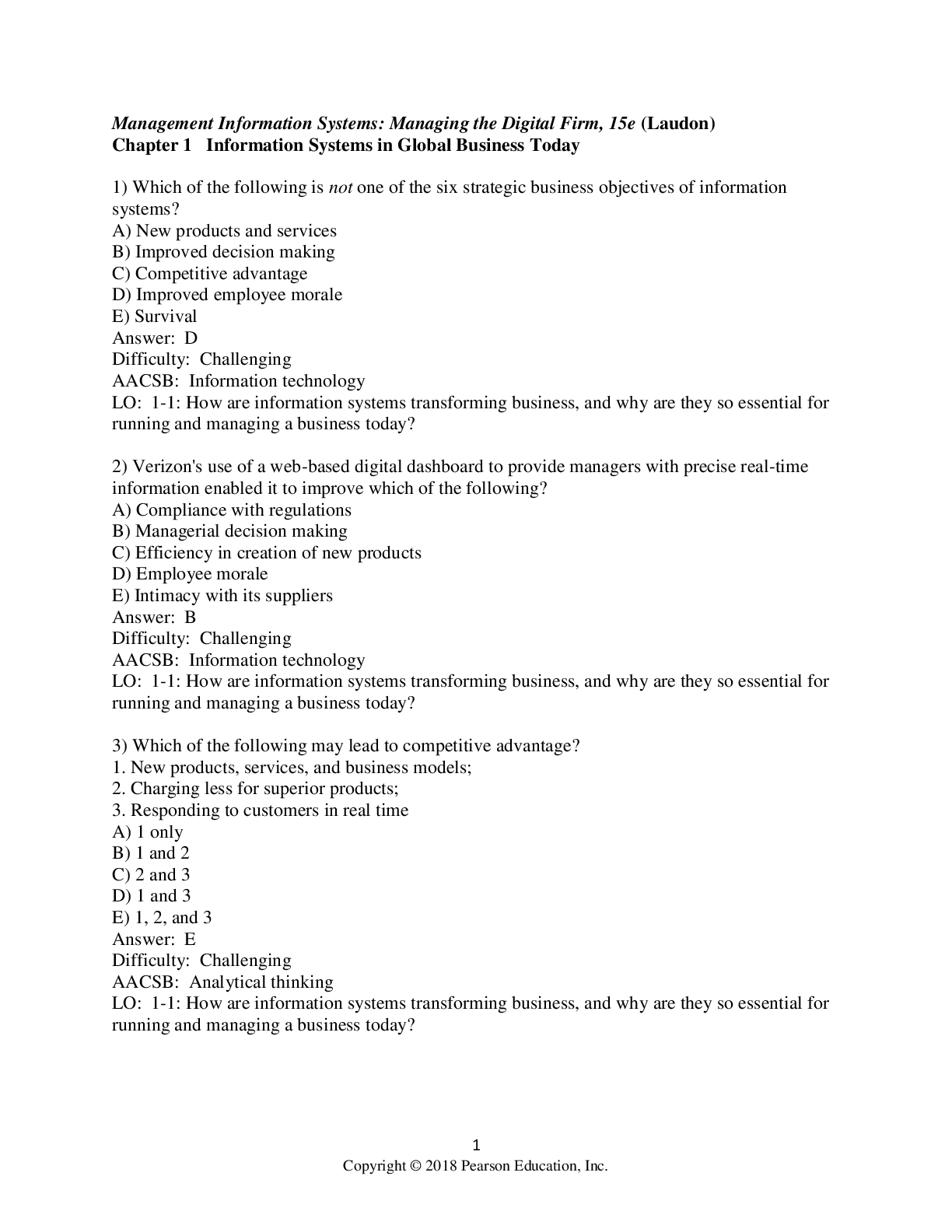
.png)
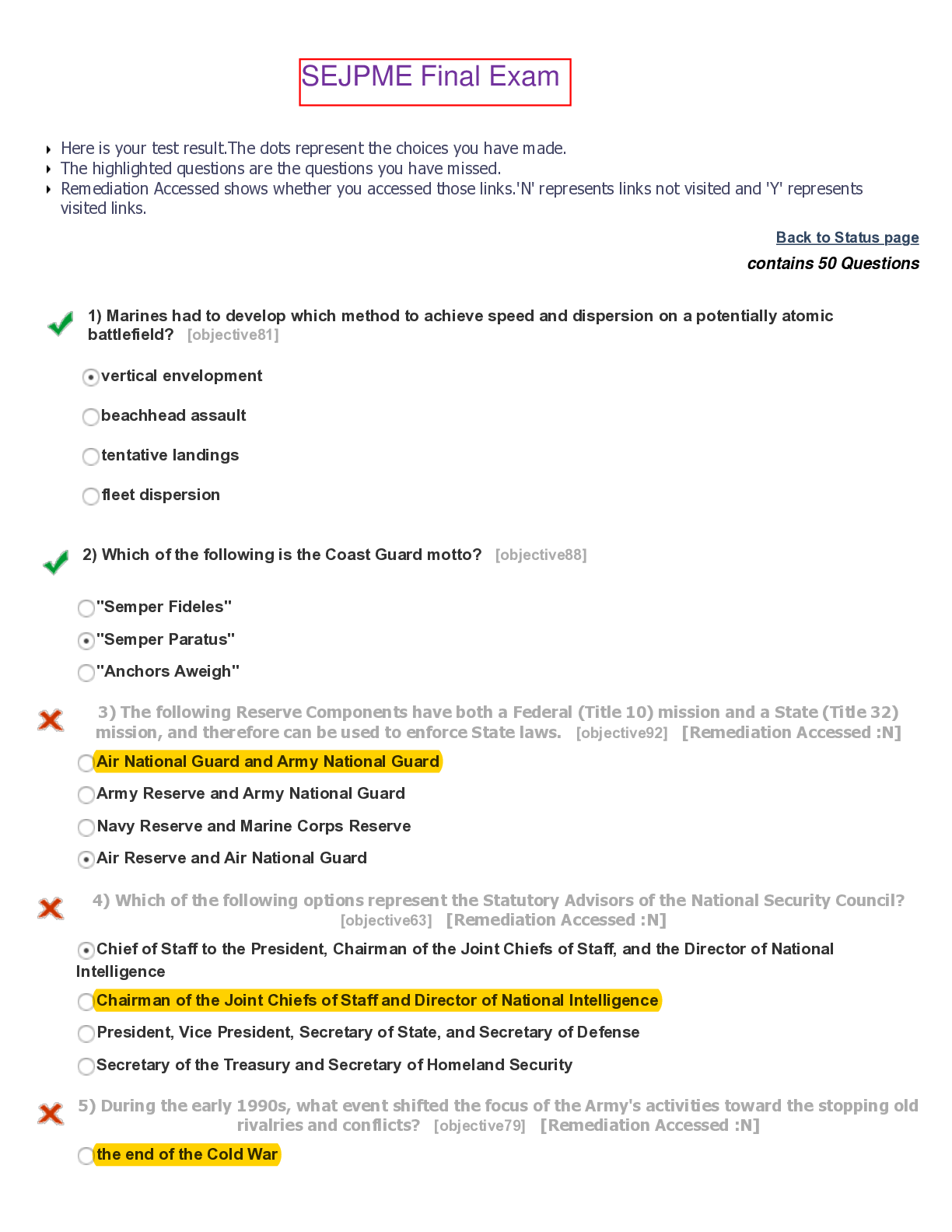


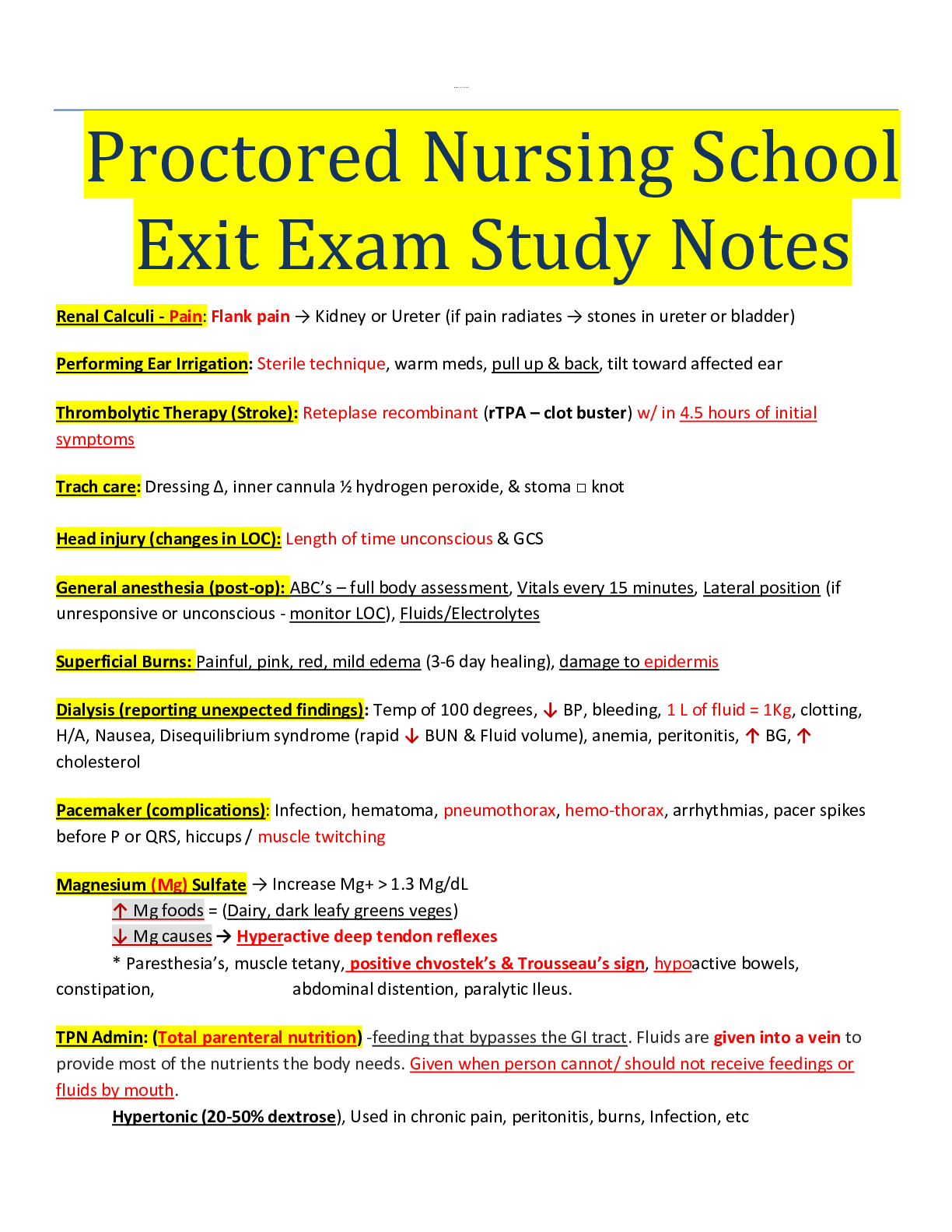
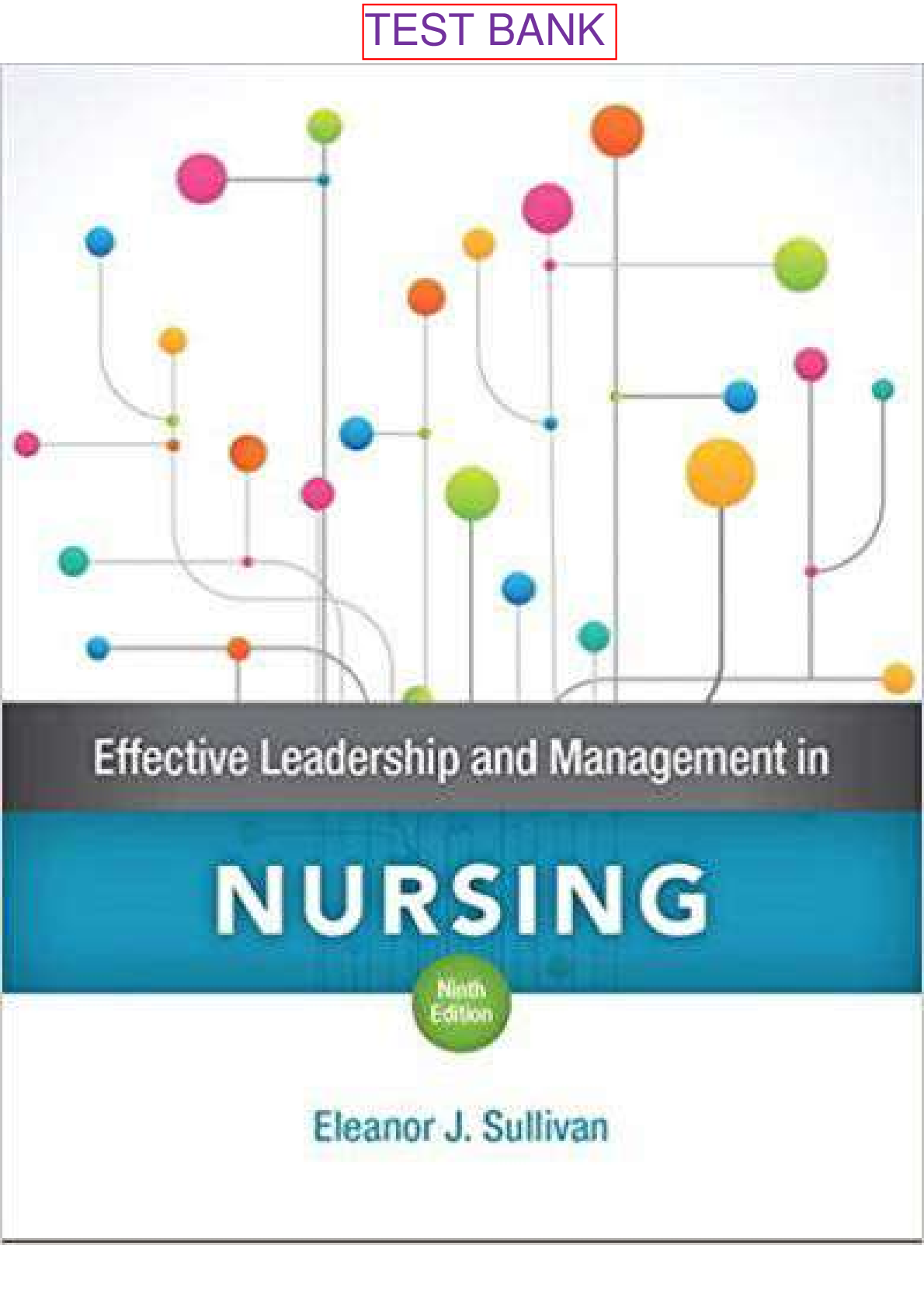
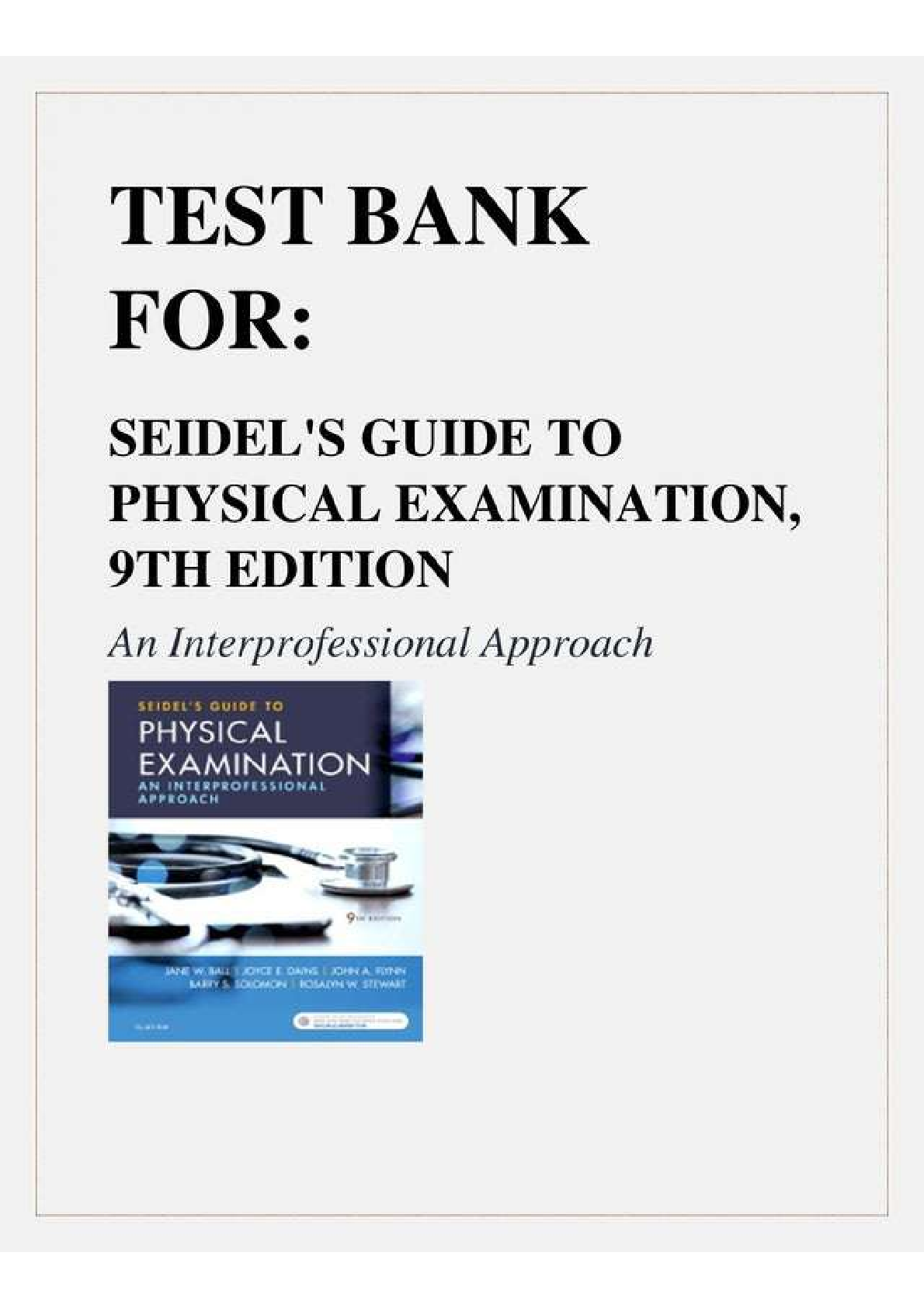
.png)
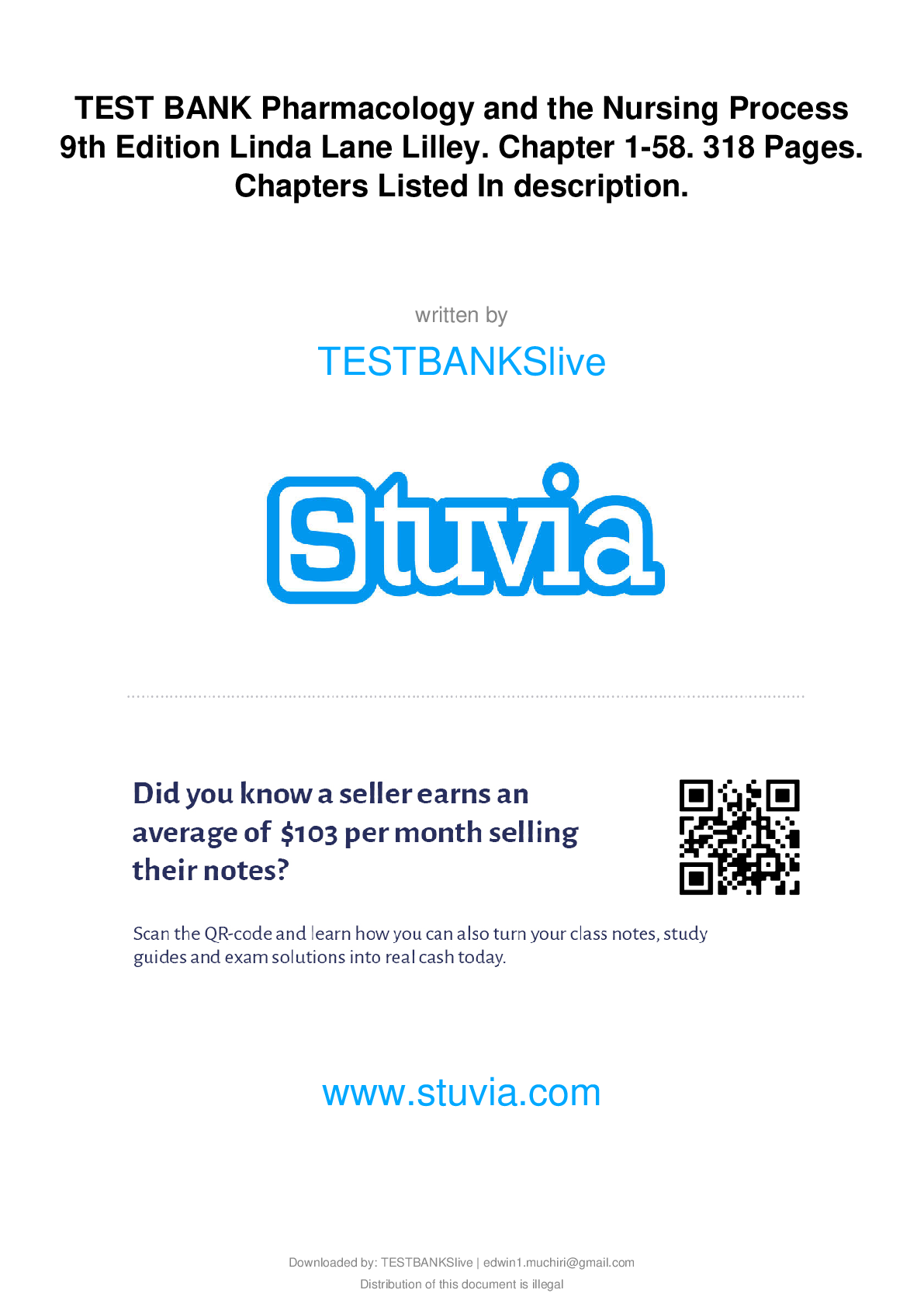
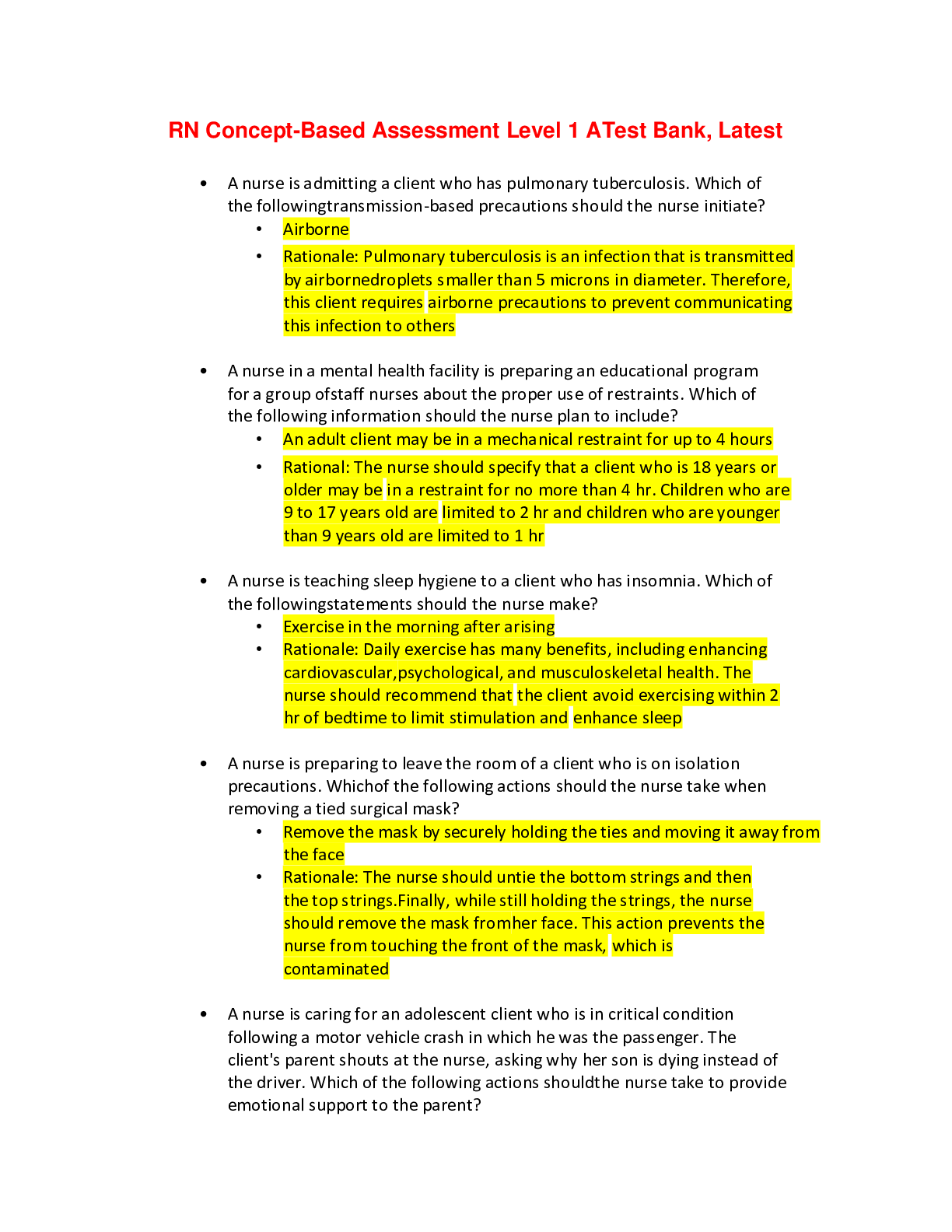

.png)

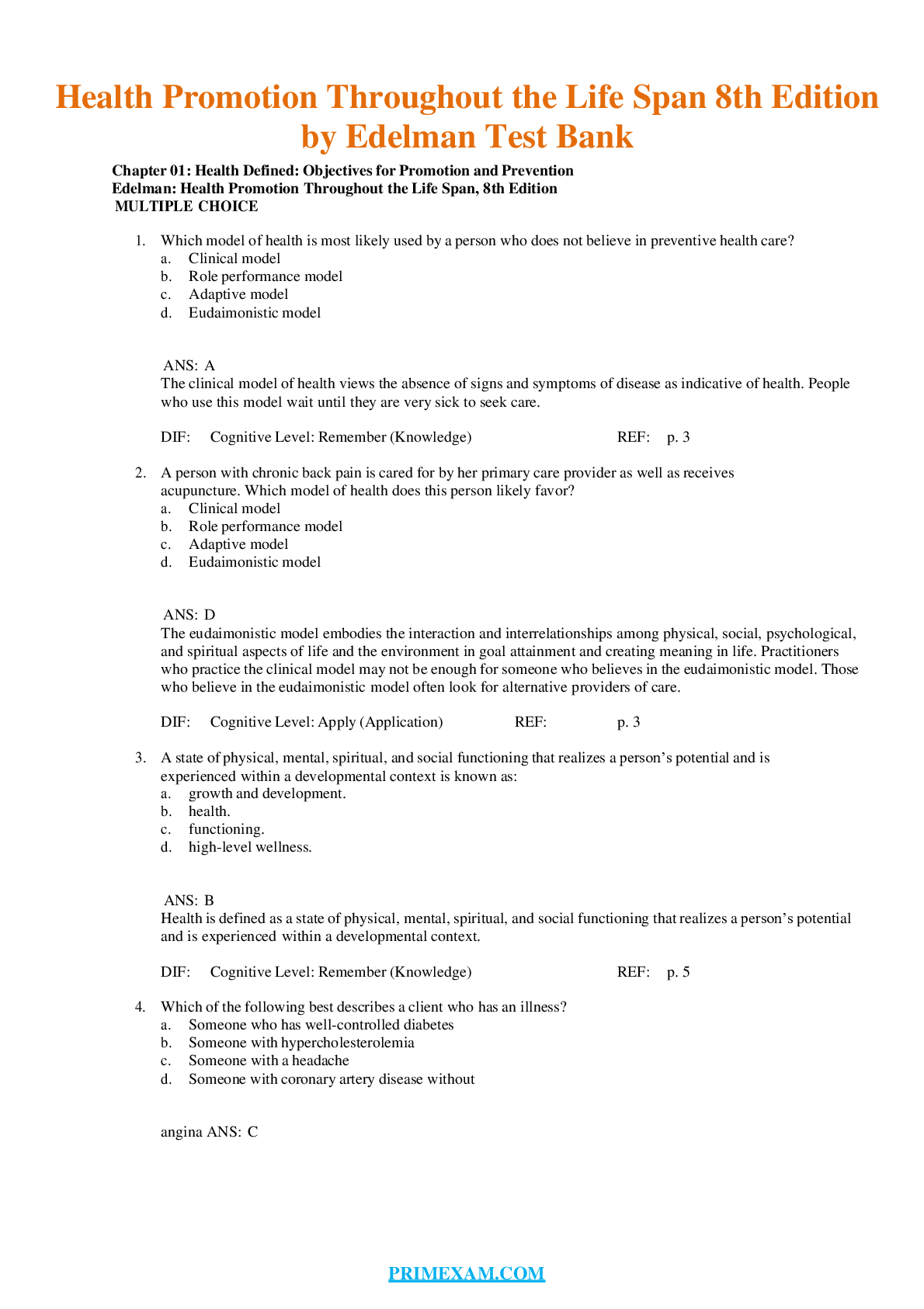
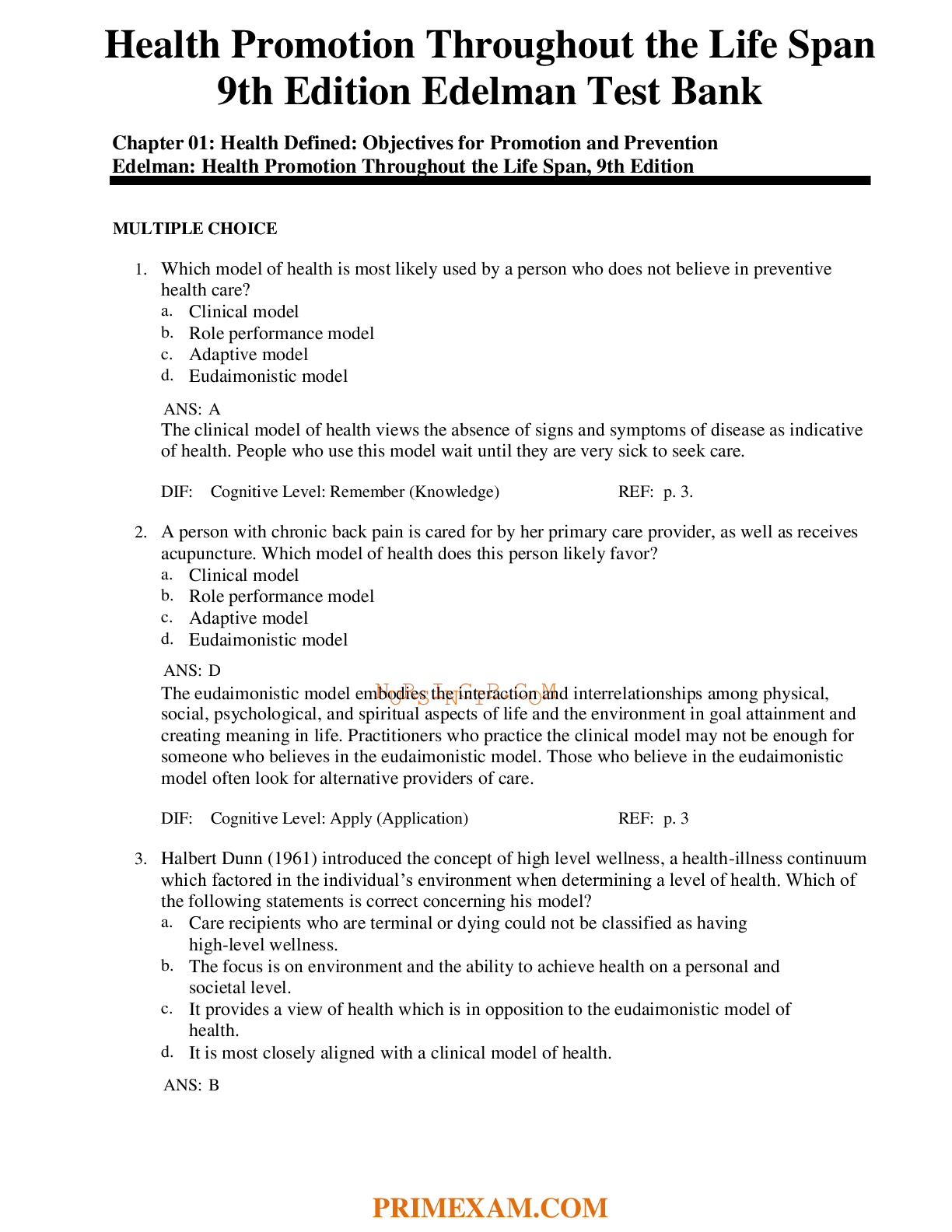
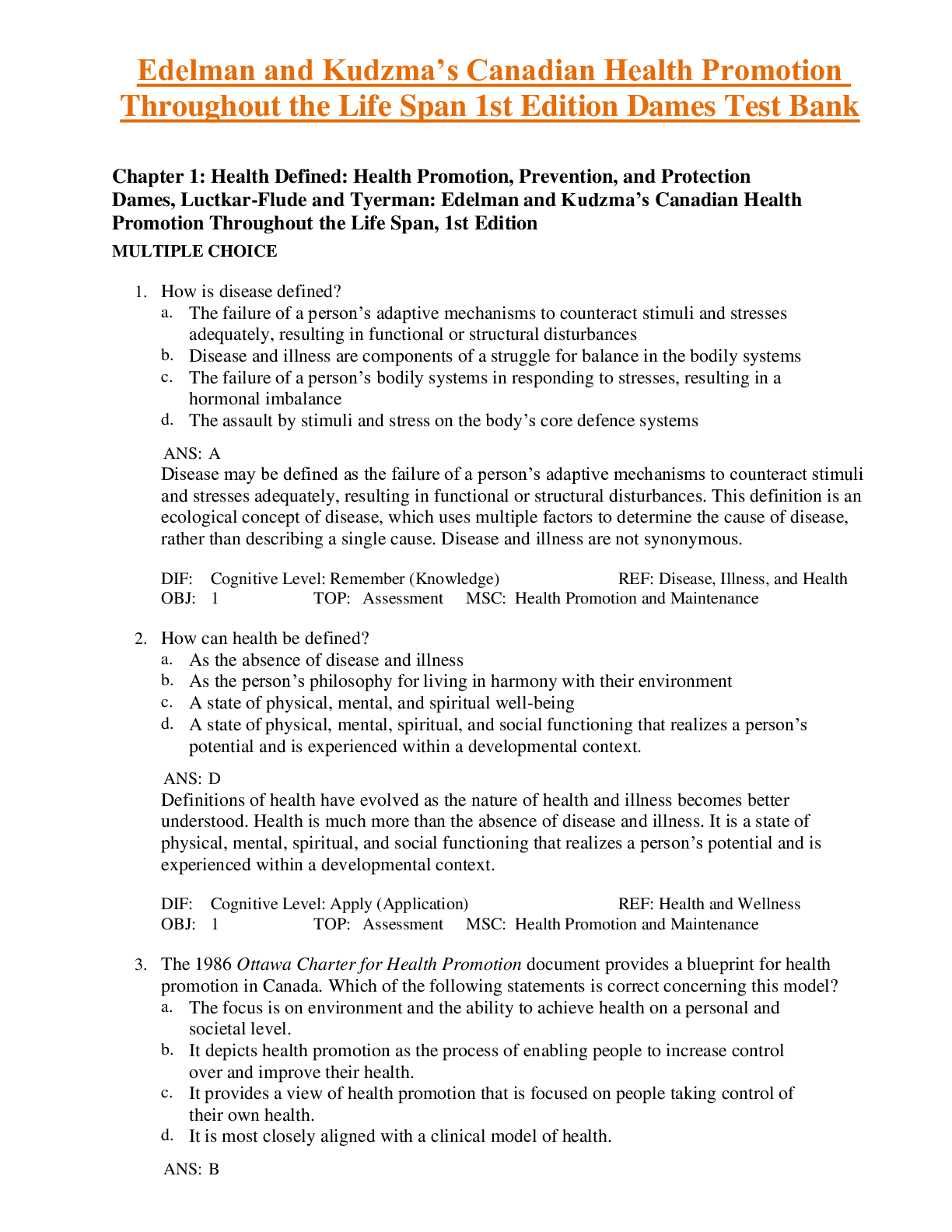

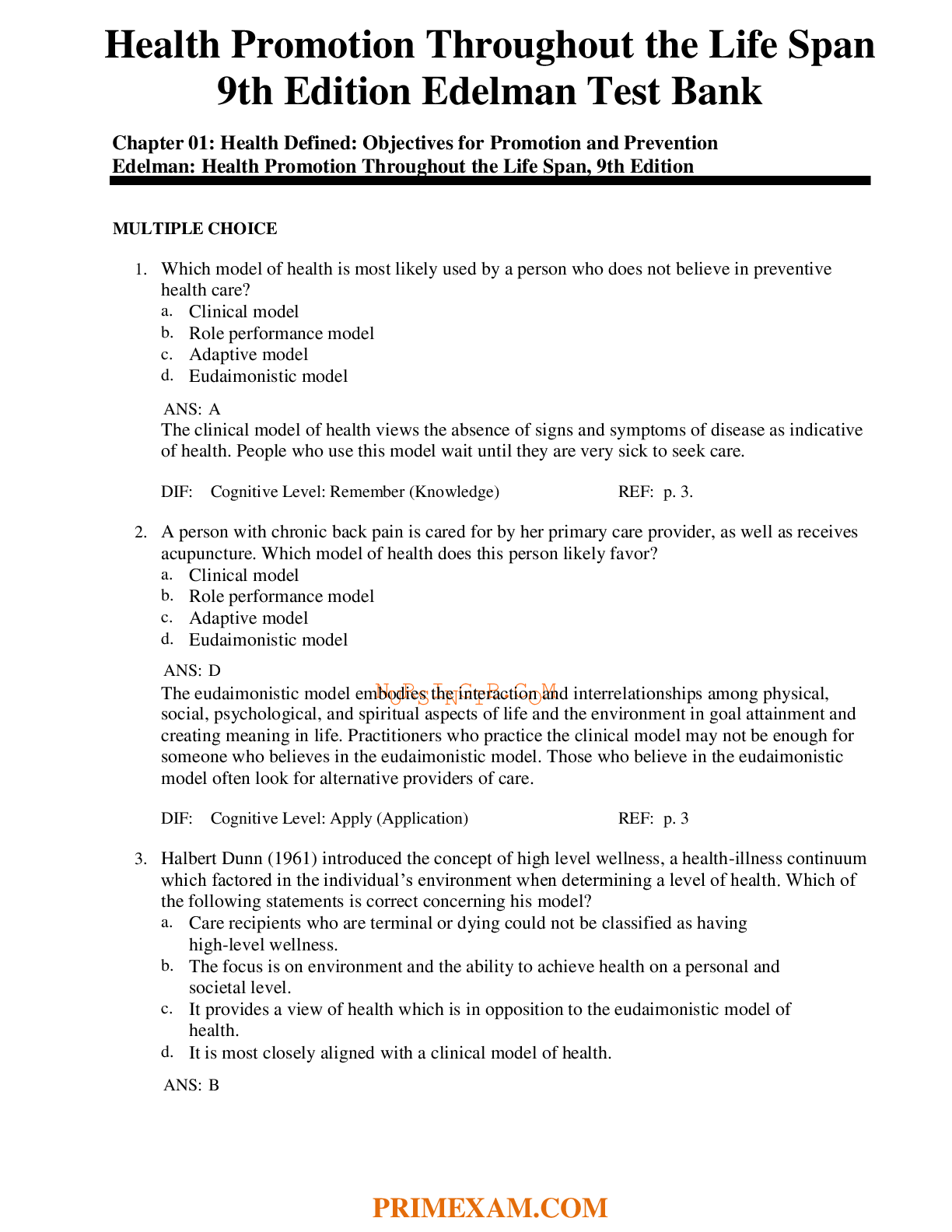
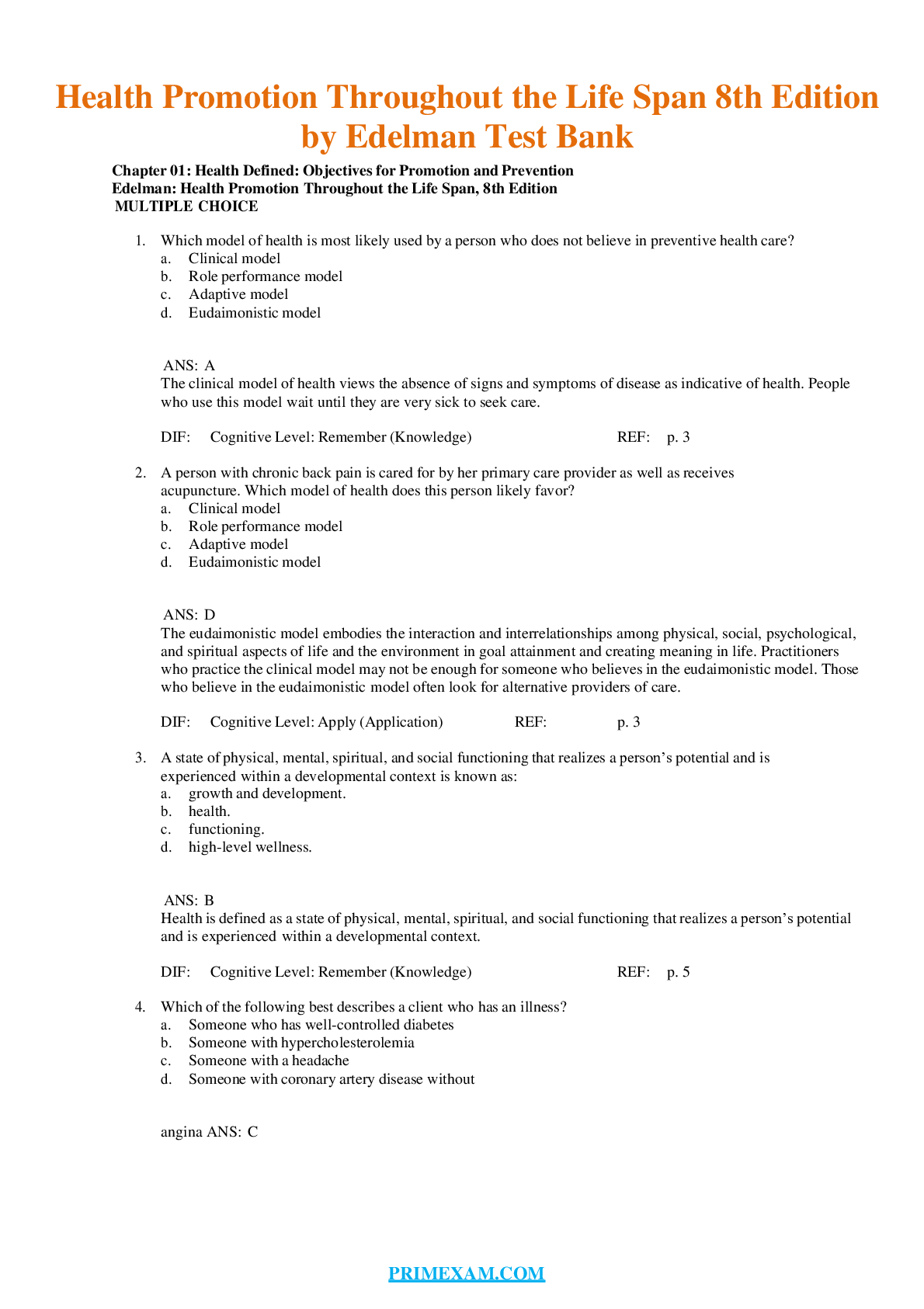

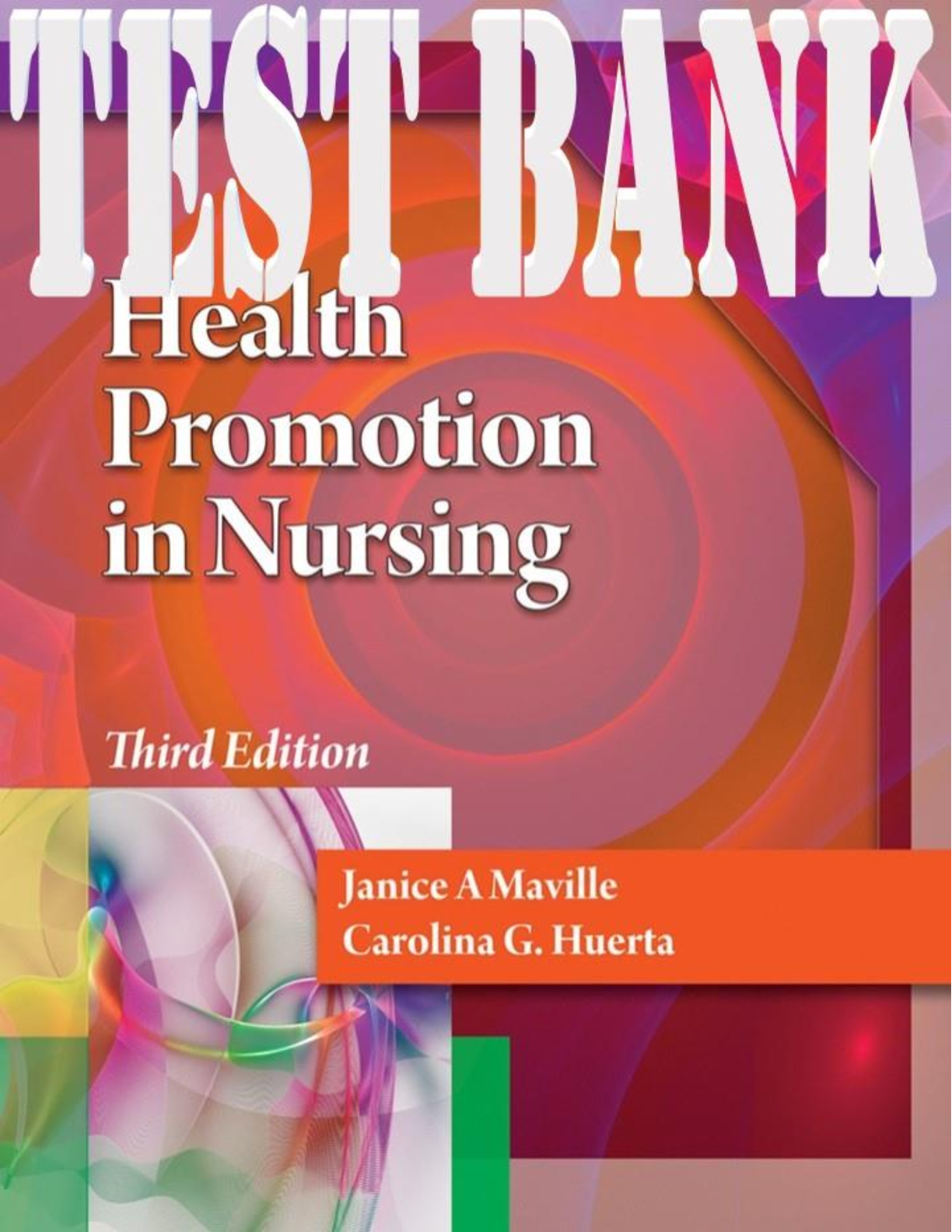
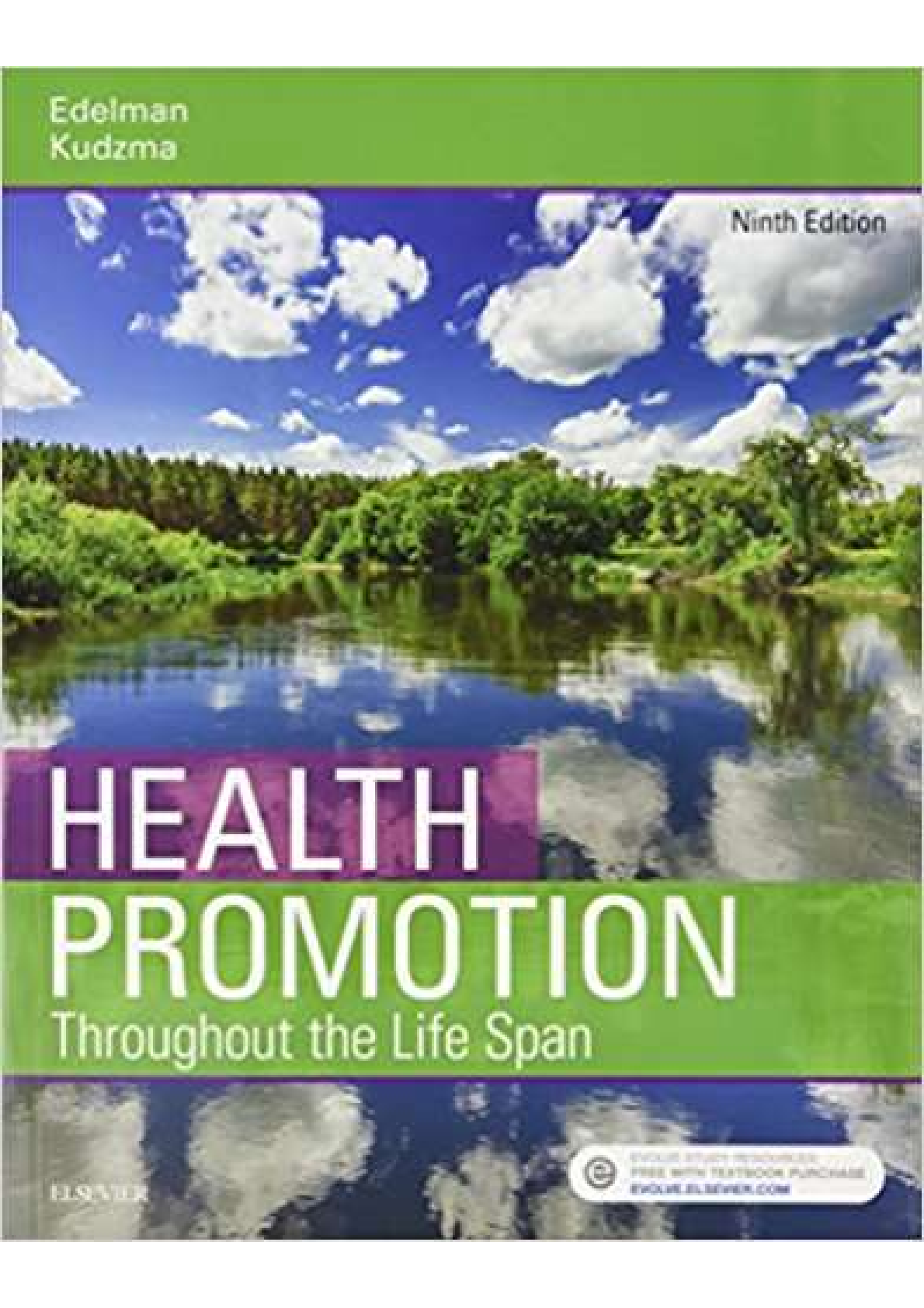


.png)
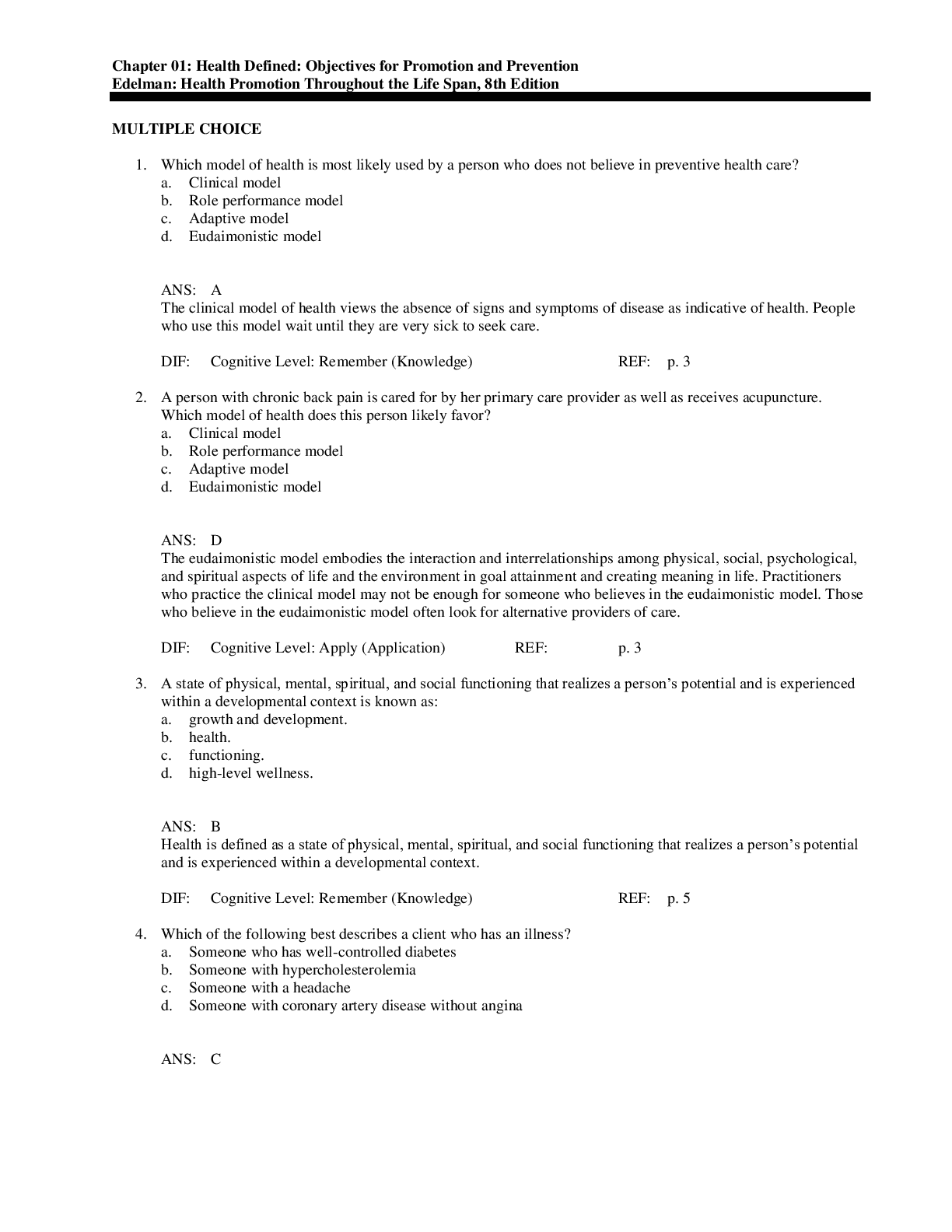

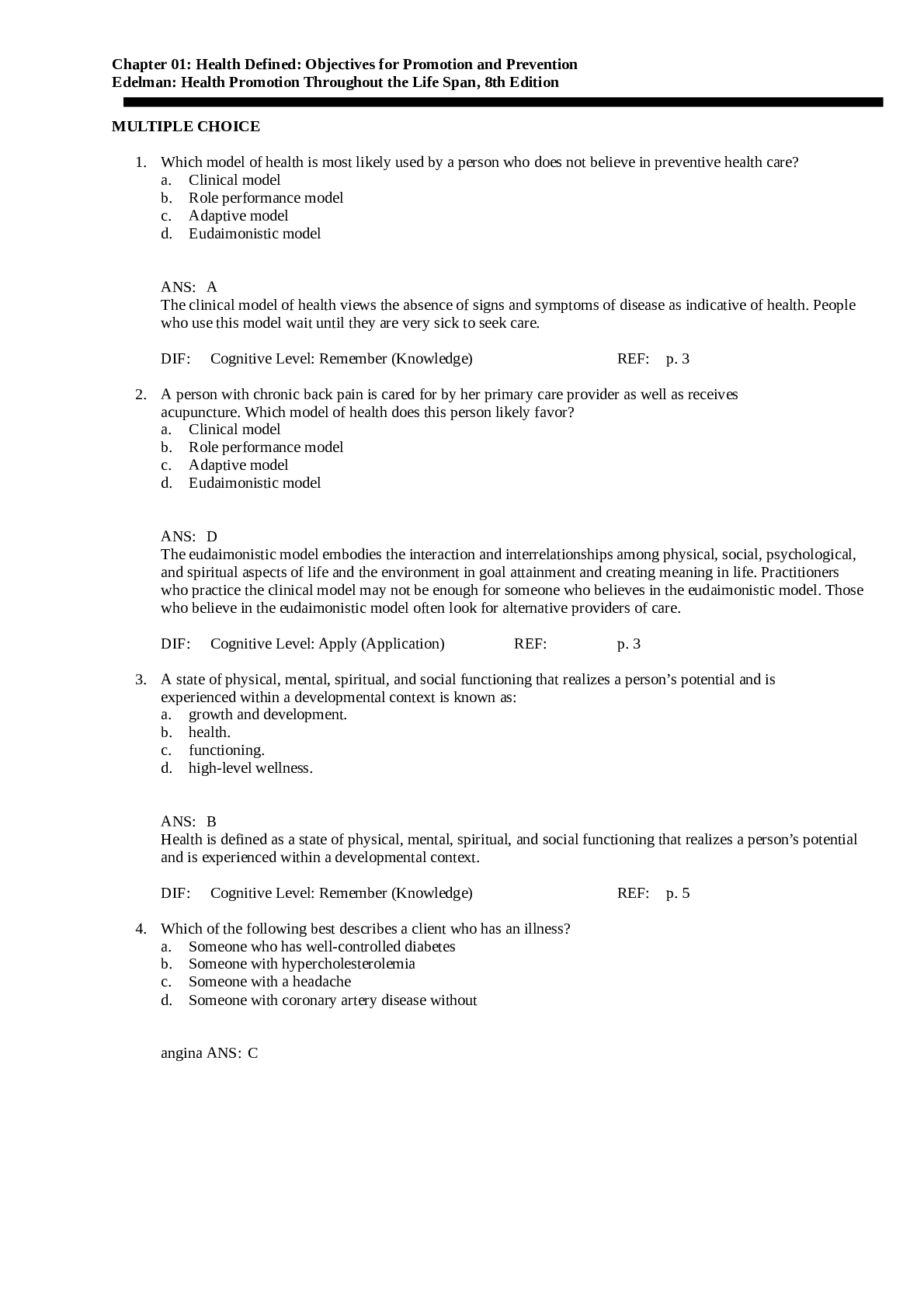
.png)
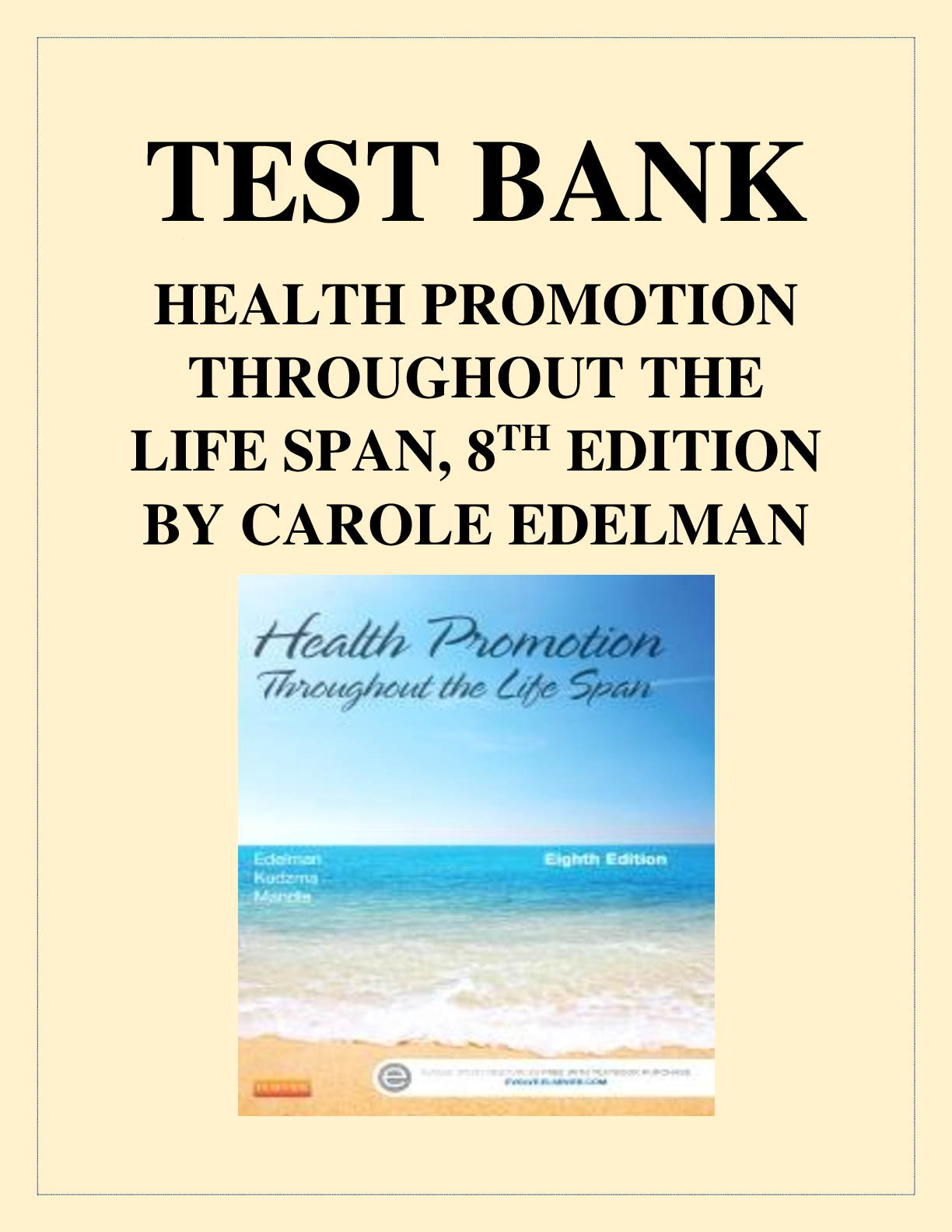
.png)

